

VIEWS
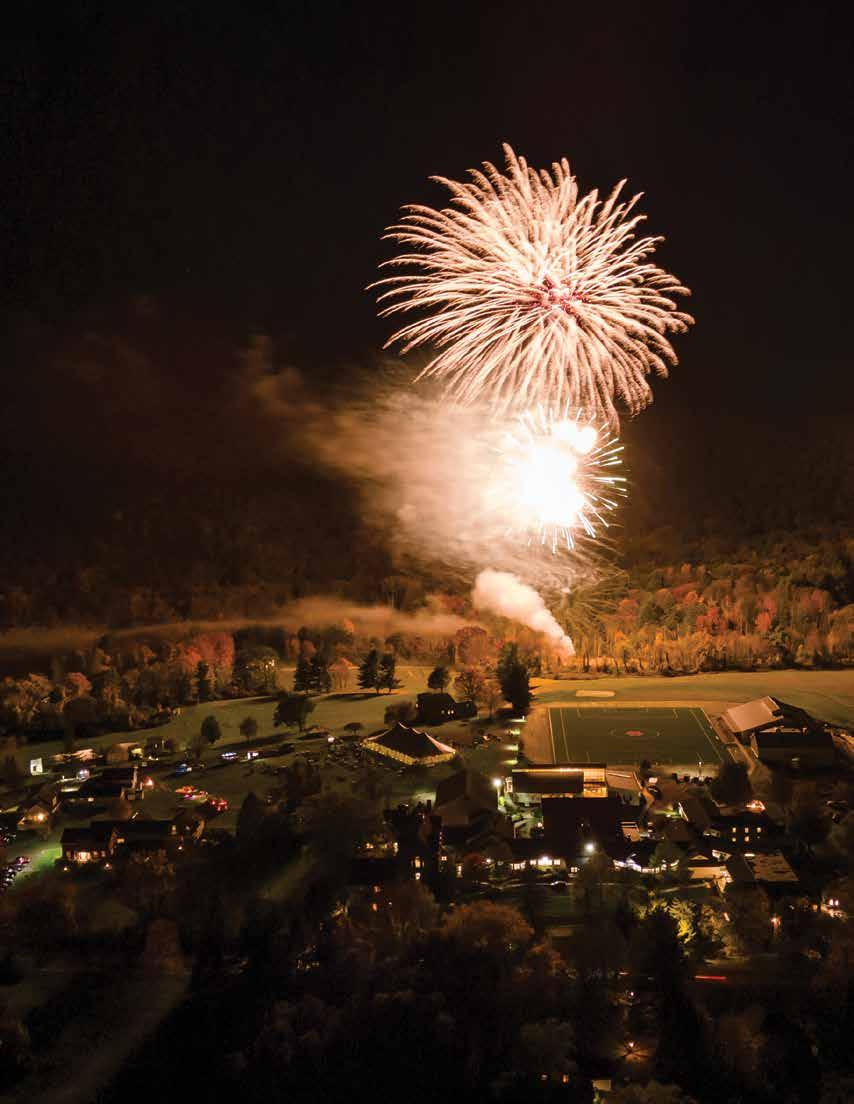
A burst of fireworks lights up the IMS Upper Campus in celebration of 100 years on the mountain.

In This Issue
2 View from Becket House
2022–2023
4 Strategic Plan: The Next 100 Years
6 Life Through Service
8 Meet Amy Tedder
10 Visual Arts at IMS
13 Athletics
14 Undefeated: IMS Varsity Girls Soccer
15 Morehead Athletic Center
16 Centennial Celebrations
20 Earth Day Every Day
23 Land Easement
24 Boarding Life
26 In the Classroom
28 Community Collaborations
31 Capital Projects
32 View from Advatncement
33 Donor Spotlights
34 The Maroon & Gray Tradition
36 How It Started ... How It’s Going
IMS BOARD OF TRUSTEES
Christopher Sanger ’86, P ’18 ’20 President
Ulrika Ekman P ’16 Vice President
Anna Traggio P ’16 ’18 ’20 ’22 Secretary
Jamil Swati P ’27 ’30 Treasurer
Lawrence Alexander
Michele Browne P ’18 ’21
Maja Clark P ’24 ’26 ’28 ’33
Leonard Fong ’93, P’22
Catherine Gouge ’01
Alexandra Jarislowsky P ’21 ’21
Limin Kong P ’23
Henry Labalme P ’19
Heehyun Lee P ’26
Esther Ma P ’21 ’22
Kathryn Mattis P ’22
Pieter Mulder P ’19 ’22
David Nuzum P ’25 ’27
Justin Royce ’96
Jeremy Spofford ’90
ON THE COVER:
We ate a lot of celebratory cake this year! This one was devoured on Centennial Weekend in October. See more celebrations throughout this issue.
Indian Mountain School
Indian Mountain School
@indianmtnschool
@indianmtnschool
IndianMtnSchool
Savannah Stevenson P ’26, ’31
Richard Turnure ’82, P ’24 ’26 ’28
Cary Ullman ’91, P ’28 ’29 ’33
Jason “JJ” Velez ’96, P’23
Lara Vitiello P ’24
Mark Winmill P ’28
View from Becket House
Message from Head of School
Jody Reilly Soja
Our First Century
In the fall of 1999, I arrived at Indian Mountain School to teach ESL and US history. I had the time of my life. The students were so kind to me, a brand new teacher who frequently had no idea what I was doing, but we had a classroom full of lively dialogue and a lot of laughter. Thanks to all of my students that year, I fell in love with teaching at this school. I was equally enamored with the School’s land, the tight-knit community, and a mission that resonated with my own beliefs. It is no wonder that I have spent half my life connected to this school. My experience here has been fulfilling in ways I never imagined, and I am deeply honored to serve as the ninth Head of School as we conclude our first century.
In preparation for our Centennial celebration this past fall, I spent a lot of time researching our School’s founding years. I poured over decades of correspondence from our founder, Francis Behn Riggs, and learned so much about the humble beginnings of IMS and the vision that has shaped the school we are today.
In 1922, Mr. Riggs started IMS because he believed in the power of education to help reduce suffering, poverty, and conflict in the world. He embraced different perspectives and sought to educate good citizens, stewards of the earth, and communityoriented young people. Our school motto, Life Through Service, was established by Mr. Riggs.
While our main building stood during Riggs’ time, it was not the original school building. The first structure that was built in 1922 burned down in 1928. I was struck by the hope and optimism of Mr. Riggs in the face of such adversity. He wrote, “The fire was a terrible and wonderful experience. It was terrible to watch the form that seemed to hold all of our visions and memories swiftly change to a shapeless ugly mass. But it was wonderful, too. While the fire was doing its hideous damage, some hundred and fifty of our friends saved all that human beings could save…A man intruding on his own funeral could not have been more encouraged than I was by the devotion of the faculty and the encouragement of our friends from far and wide.”
Many of us can relate to the idea that a tragic and terrible event can also be wonderful. As we took refuge on this campus during the pandemic and during a time of politically and
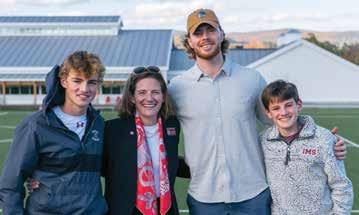
racially charged unrest, we discovered the beauty and power of a community that is committed to protecting the well-being of its members, and the strength that comes from a collective experience. Some of my proudest moments at IMS during that time were when we were managing hardships together: the generosity of spirit, the display of character, and the constant willingness to pitch in to help was humbling, awe-inspiring, and encouraging, just as Mr. Riggs referenced his friends during the fire.
Mr. Riggs’ portrait hangs in my office behind my desk. I often wonder, is he proud? Could he have envisioned a school enrollment of 300 students, co-educational, diverse, with students from all over the world? Could he have imagined two campuses and more than 600 acres, not to mention a spectacular new athletic center and playing field? Are we living out his vision? I believe we are.
As we have emerged from the restrictions of the pandemic, it has been wonderful to resume community building both on campus at the spectacular centennial celebration, as well as around the world. The support from near and far has never been more keenly felt as we celebrate the accomplishments of our community, and continue to build strong and lasting relationships.
I am proud to share this centennial issue of Views magazine. I hope you will enjoy reading about our new strategic plan, curricular updates, and capital projects, and much more as we welcome and embrace our next century.

Russell Soja ’22, Jody Reilly Soja, Emmett Morehead ’17, William Soja ’24 at the ribbon cutting for the new Morehead Athletic Center
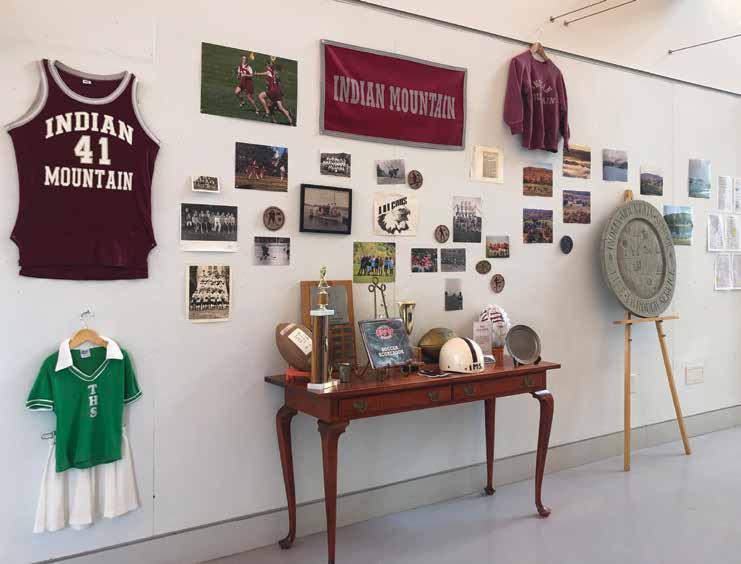
Mountain Milestones
Centennial Exhibit Takes Viewers on a Stroll Through IMS History
In honor of our centennial, a group of campus sleuths spent months building an impressive collection of photographs, artifacts, and a century of writing. The assembled items were curated and put on display in the Student Center.
The exhibition was called “Alumni Centennial Exhibit: 100 Years on the Mountain.” Visitors strolled through IMS history, learned about the school’s milestones and enduring traditions, and viewed school trophies, vintage uniforms, artwork, and so much more. The exhibit first opened on Centennial Weekend, October 14–15, 2022.
Throughout the pages of this magazine, you’ll find photos pulled from the IMS archives— snapshots of our history and the road we’ve traveled. Look for our archive icon!
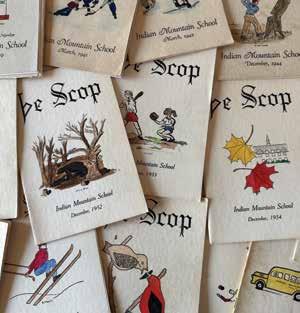
Le Scop
Part of the Centennial Exhibit included issues of Le Scop, our school newspaper which was first published in 1925. The pages in these beautiful booklets contain a treasure trove of school news, creative writing, drawings, and photographs. Le Scop eventually went out of print. This year, a group of students took it upon themselves to bring Le Scop back, in the form of a school newsletter.
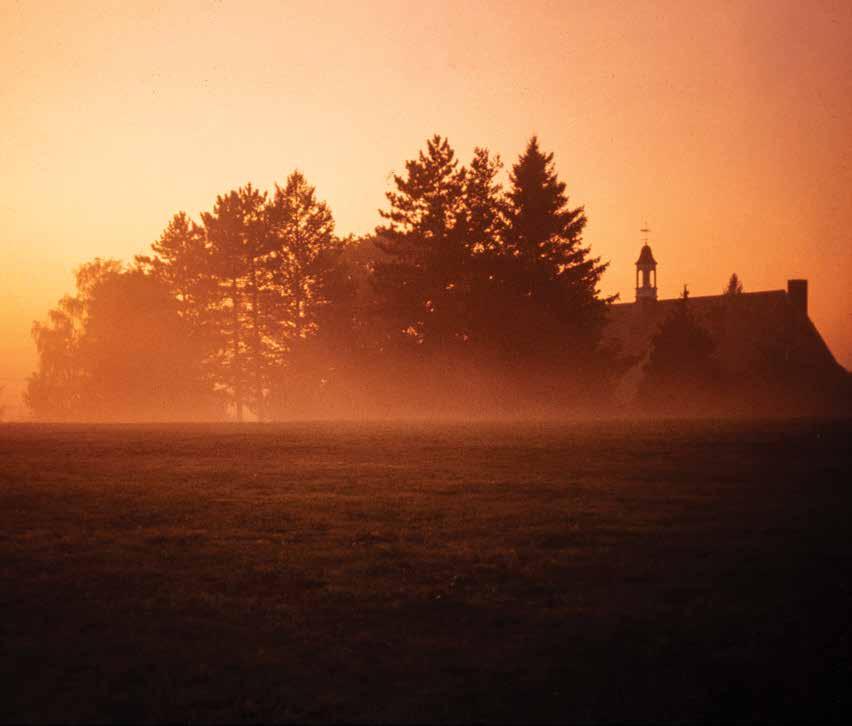
Courage to Climb Higher
A New Strategic Plan in Service of Our Future
Indian Mountain School inspires in each member of our community the courage to climb, the passion to learn, the joy to create, and the spirit to contribute in kind and meaningful ways.
From the archives: campus at dawn, 1980s
In the fall of 2017, IMS published an ambitious, first-of-itskind strategic plan that would stretch us beyond our comfort zones and into a new era. Over the years, the pages of that plan became worn and dog-eared, referenced and used as a map that would lead us into the start of our second century. It was impossible to predict that we would be tasked with carrying out this plan amid a global pandemic and with such uncertainty about our future. None-the-less, the work that was identified using our previous plan enabled us to achieve excellence in many aspects of school life, clarifying and improving our programs and curriculum, investing in our people, achieving record-breaking fundraising milestones and enhancing our physical plant. We are proud of these accomplishments, and we have further to climb.
We’re proud to present “Courage to Climb Higher,” our new strategic plan. It builds on the legacy of our previous plan and acts as a framework for our mission, clearly defining our next goals and making us all accountable for them. At the heart of it all is our community.
As we reflect on our centennial year and acknowledge the courage that was required to reach this milestone, we are eager to turn our focus toward the future with renewed passion, joy, and spirit.
Read the complete plan at indianmountain.org/ couragetoclimbhigher
“The
paths taken at IMS are just like the paths up our mountain: different for everyone, rarely in a straight line, and ultimately rewarded with new perspectives, an expansive view, the spirit of possibility, and the tools necessary for the challenges and opportunities ahead.”
Excerpt from our IMS Vision Statement
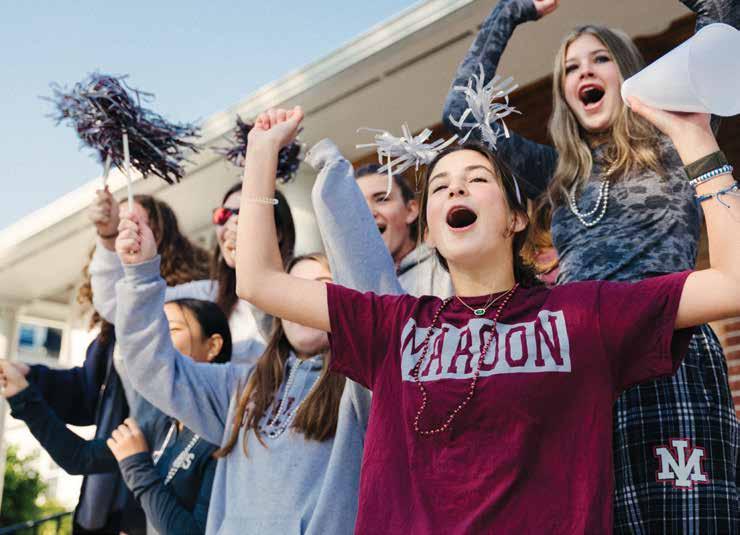
Educational Excellence
We believe in the unlimited potential of all learners in our community, and that the most impactful learning happens when students are engaged with their peers, studying and addressing real-world issues.
The Mountain
We believe our expansive natural setting provides essential opportunities for learning about our environment, cultivating leadership and action, and encouraging outdoor play and personal growth.
Belonging
We believe in Francis Behn Riggs’ founding vision of a school that is accessible to all students and where everyone feels a sense of ownership and belonging.
The Joy of Childhood
We believe that when school is a joyful place, and where students are challenged, engaged, and encouraged to play and develop meaningful relationships, children’s potential becomes limitless.
The
Next 100 Years
We believe that it is our responsibility to focus on the longterm sustainability of our beloved school, to ensure that it is thriving and available for future generations of IMS students and community members.
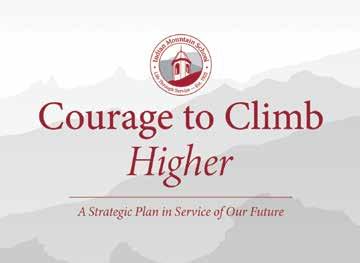
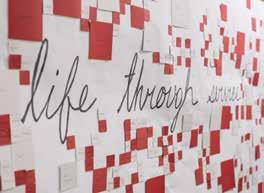
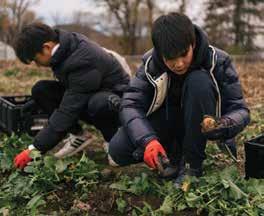
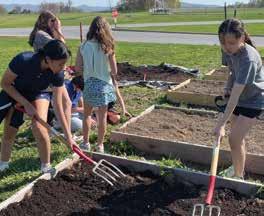
1922 Hours Community Service Challenge in
Honor of our Founding Year
In our humanities hallway, we have a display of paper squares, each one depicting hours of community service completed. It’s a continuously growing, real-life representation of our motto, Life Through Service. Each hour completed also earns a point for the volunteer’s respective Maroon or Gray team. As the mural takes shape with reflections of selfless work, it also builds anticipation for which team will come out on top at the end of the year. Really, though, everybody wins.
The IMS Community rises to the challenge that our school motto asks us to meet. Each hour of service adds strength to our community, connection, and purpose.
Francis Behn Riggs founded Indian Mountain School in 1922 after donating his home and farm to the school. It’s perhaps no surprise that much of the community service work that students do each year is connected to the land on campus and in our community. In the fall, students helped to clear land at the Sharon Land Trust, chopped and stacked wood at April Hill, and cleaned up trash on Indian Mountain Road. A large majority of hours this year have also been spent helping other organizations in the tri-state area, most notably the Northeast Community Center (NECC). Students help prep the center for biweekly food pantry pickups, by sorting health and wellness supplies, bagging pet food, loading and unloading food for the food bank, and harvesting end of season crops from Rock Steady Farm in Millerton for distribution at the food pantry. This spring, students helped prepare garden beds at the NECC
Left: Students work the land for the Northeast Community Center Below, from the archives: Crop Walk, 1990. IMS participates in this event every year, raising money to help end food insecurity.
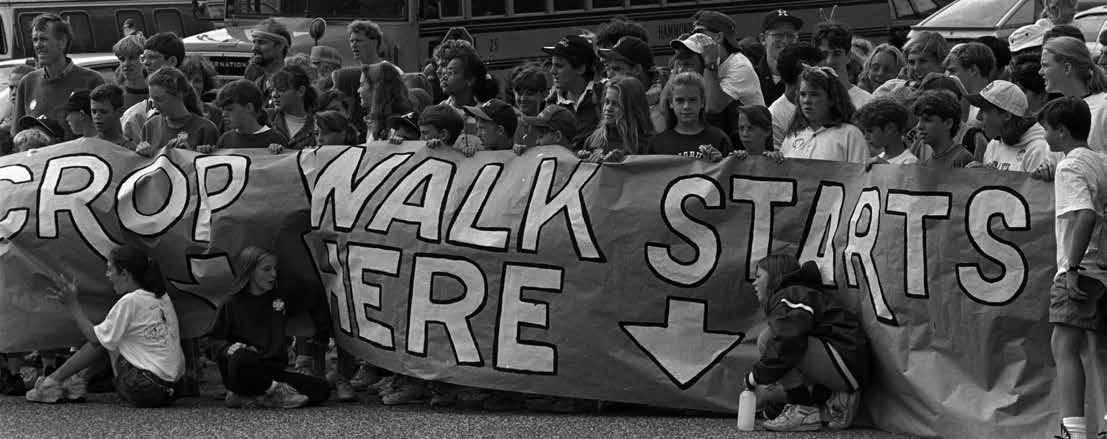
“Through community service, our students see the real world connection between action and impact, and they can understand the positive effects their efforts have within their community and themselves.”
Colleen
O’Reilly & Tammy Decker Co-Chairs of IMS Community Service
community garden at Webutuck High School. The food grown there will support the breakfast and lunch program for kids, and the community kitchen meals over the summer months.
Students also spent time indoors, reshelving books in local libraries, assigning library cards, and organizing community Magic the Gathering events. They helped run lines in the fall during the annual Varsity Girls’ Soccer tournament, raised funds and awareness for the Jane Lloyd Fund, and supported the Lower School Afterschool program. Likewise, our faculty (outside of their IMS responsibilities) volunteered their time coaching youth sports teams, driving the local volunteer ambulance, and supporting other non-profit organizations. It has been heartwarming to see how the IMS community rises to the challenge that our school motto asks us to meet. 1922 hours were not only achieved this year, they were surpassed, each hour of service adding strength to our connection and purpose.
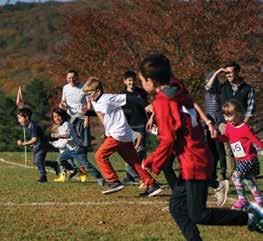
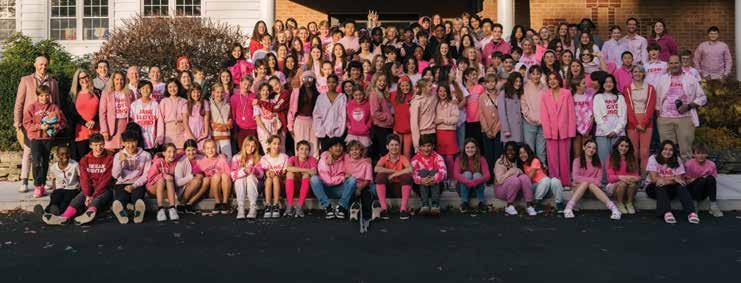
In October and November, the IMS community came together to raise awareness — and thousands of dollars in funds — for men’s and women’s health initiatives. In October, we raised money for the Jane Lloyd Fund and celebrated with Pink Day, and November was “MOvember.”
IMS Music Department Chair Ram Miles was the recipient of the Mountain Moustache, for raising a record amount for men’s health this year.
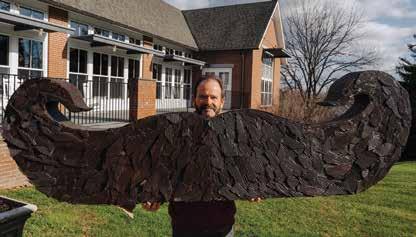
The first annual Falcon 5K and Fun Run, in support of the Housatonic Youth Service Bureau.
Be Bamboo
Life Lessons From Our Interim Head of Lower School
By Amy Tedder
As long as I have been a teacher, the same thing happens around springtime every year: I am struck by how connected I feel to my classroom of students. Every year, this is a hard-won reflection and I am reminded that this is the magic of teaching elementary school students: a joyful sense of community and belonging.
This year was different. I did have that moment of reflection and remembering, but I realized that my relationship with my 12, fourth grade students is unlike any I have had before. We weathered unique hardship together and in the doing — in all those morning meetings and reading groups and math lessons, social studies projects, and class games — something very special was forged: an authentic kind of trust I didn’t know was possible.
June 7th, 2022. I was wrapping up my tenure at Mirman School in Los Angeles, CA and was preparing to move across the country to take up a teaching position here at Indian Mountain School. I had been checking in with my healthcare provider and was awaiting the results of a biopsy which I assumed would be benign. As a cancer survivor of stage IV Hodgkins’ Lymphoma at age 16, I had long since worked through the intense fear of relapse or some other cancer diagnosis. I didn’t even consider that as a possibility anymore. After all, I thought, no one has luck that bad.
The 6pm phone call with my nurse practitioner was a quick blow to my reality. Here I was again and not a single person could say why. There was no known connection between the Hodgins’ Lymphoma and the treatment I received for it and the triple positive Invasive Ductal Carcinoma (breast cancer) that I now faced. The summer was a whirlwind of insurance battles, transferring my medical records, moving our belongings 2,000 miles, finding housing, and trying not to lose myself in the process. My husband Mike and I held each other in every way we knew how while we gritted our teeth through our two year wedding anniversary that August.
We were equally as rocked, though, by how our friends and families showed up and knit a net of support for us. Amy and Tom Vorenberg (then Head of Lower School and History Department Chair at IMS) jumped into action and through their help, we found a superb surgeon and medical team at Yale New Haven Hospital, and had a place to stay while we sorted through everything else. Amy, Tom, and the Indian Mountain
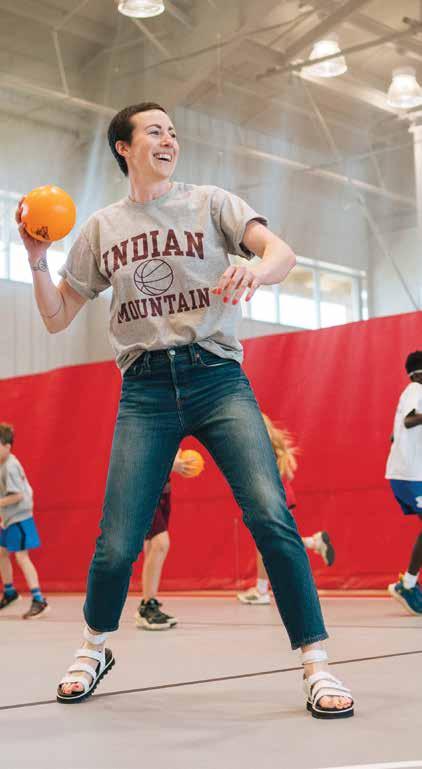
School community started to show us that we might, just maybe, make it out of this catastrophe in one piece. The fourth grade parents who had only just met me brought us meals once a week for the first three, painfully hard months. I started to believe I might be able to keep my teaching job while undergoing chemotherapy, surgery, radiation, and endocrine therapy.
I met my new class of students with a shaved head — the chemotherapy had already started causing my hair to fall out. They loved it and refused to agree that I was “bald” while any trace of hair remained. It was the first of many moments where they, 9 and 10 year old children, showed me I could be exactly
Amy Tedder at the grand opening of the Morehouse Athletic Center
who I was, regardless of what I was going through, and they would accept, embrace, and trust me anyway. When I talked to them about how I would be out for treatment in New Haven once every three weeks, and how, after chemo, I might feel too sick to come to school for a few days, they accepted it. We dreaded those days together. And when I found out that I was finished with chemotherapy for good, every single one of them cheered and jumped up and down on the basketball court like it was their great victory too. We all hugged on the blacktop and I cried. I will never forget that moment.
“The bamboo that bends is stronger than the oak that resists.”
Japanese proverb
Now I find myself finishing up the very last steps of treatment while my soon-to-be fifth grade students measure my hair growth every few weeks and beg me to keep it short because that’s the Ms. Tedder they know. These twelve students, their families, the Vorenbergs, and many others in this special IMS community have given me something I did not know I had lost: faith in others to hold me up in my time of need. Words can never fully express the gratitude Mike and I feel for this place and the people that have shown up for us while we have continued to push forward and find a sense of home here.
During the month of October I shared some of my story with the IMS students on the Upper Campus in honor of Breast Cancer Awareness month. I talked about resilience, a word that we’ve all heard, especially in the last few years. What does being resilient actually mean, when you are going through tough times, whether it’s your health, your work, or your relationships? I cited a Japanese proverb that says, “the bamboo that bends is stronger than the oak that resists.” Through my first battle with cancer as a teenager, I thought being resilient meant being an oak tree. Staying strong, hard, immovable, and stoic. Now I know that being resilient means swaying in the storm, leaning on the people who offer help, so as not to break, and finding ways to grow in whatever kind of soil you land in. After all, bamboo never grows alone, it grows in a group, gaining strength from other bamboo.
While I prepare for my role change to Interim Lower School Head, I will use what I learned from my students this year: that we can all lean on each other and grow as a community. We can be vulnerable and strong, flexible and durable. We can all be bamboo.

Mentors Making a Difference
Twice a week, students from the Upper Campus spend time with our Pre-K through 4th graders on the Lower Campus, reading, playing games, and engaging in creative activities, and mindfulness exercises. The IMS Mentor Program allows our older students to be role models and gain leadership skills, and for our youngest students to be inspired, feel supported, and grow academically and socially.
“The way we grow up as people is impacted by the people we grow up around.”
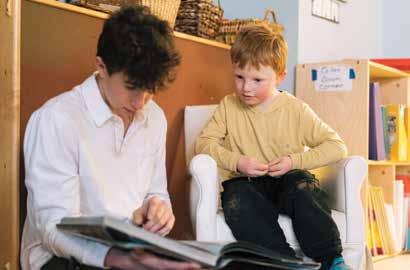
Eloise Prinz, ’23
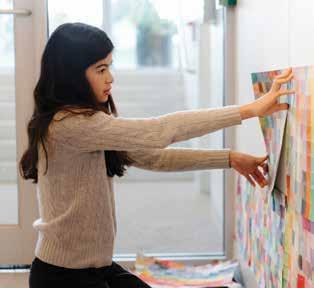
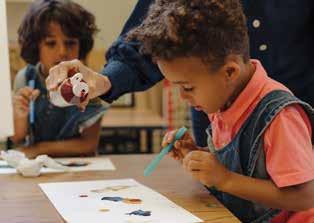
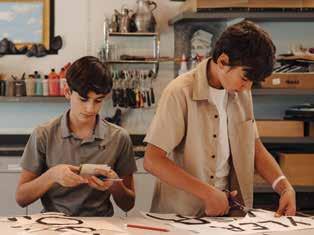
Speed Round: Who’s Your Favorite Artist Right Now?
Victor Visockis: David Hockney, Sarah Sze
Amy Jenkins: Nick Cave, Titus Kaphar
Craig Pecchia: Louise Nevelson, Louise Bourgeois, Fujiko Nakaya
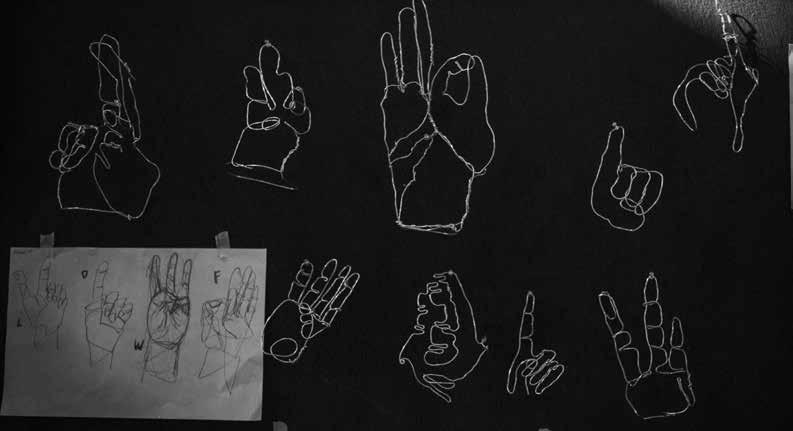
Artistic Flow
The Visual Arts Program at IMS
In the gallery space of the Student Center, natural light streams in through the large windows and the whole building overlooks the mountain — a stunning backdrop which sets the stage for student creativity. This is where students come to create art under the skilled guidance of our visual arts department: Victor Visockis, Amy Jenkins, and Craig Pecchia.
“I know it’s called the Student Center, but it’s really the Art Center,” says Mr. Visockis, Art Department Chair. “The stuff that happens here is all creative. Sets are being built, music is being played, we have the maker space, and then our art rooms.” Looking around his studio space he adds, “Every teacher has their own flow. I have pottery over there, that space is mostly for woodworking, that’s the printing press on that side. The cabinets are for the smaller supplies — pencils, erasers, brushes, and things like that. And the tables can easily be moved around.” Teaching students in grades 5–9 plus electives means that during any given week, there could be five or more different creative processes happening in this room alone.
Across the hall, Ms. Jenkins is laying out quilt pieces for an ongoing project (see page 12). She teaches art to students in Pre-Kindergarten through Grade 6. “This program is facilitated by magpies!” she exclaims. “We’re always researching, going to art shows, and also gathering things: shells, leftover glitter, a barrel of cork, scraps of fabric. Anything can spark inspiration.” For example, one year, students twisted and molded aluminum wires left over from the solar field installation into American Sign Language gestures.
Next door, Mr. Pecchia is putting the finishing touches on an elaborate and highly technical set piece for the school play (see inset). Besides teaching general art, his specialties are wood working and set design. “Our students get to try so many different things and be creative in so many different ways. And it’s really collaborative. The students and I figure out things together, they learn from me, and I constantly learn from them.”
The Art curriculum at IMS mirrors the art rooms and these teachers, in a way. There’s purpose and structure, but there is also space for creative expression, allowing for a fluid and responsive way of designing the projects each year. Each teacher brings a set of skills to the table: Mr. Visockis holds advanced
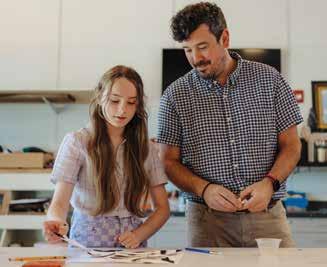
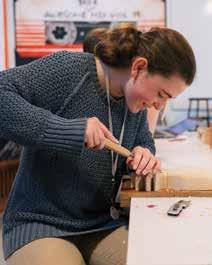
degrees in fine arts and ceramics, Ms. Jenkins in fashion, and Mr. Pecchia in sculpture and film. “We bounce ideas off each other all the time. Craig, Amy, and I will sit down and map out the curriculum,” says Mr. Visockis. “One of us will have an idea for a project and we’ll get together and figure out how to make it happen. Each year is different, but we’re still teaching the techniques and exposing students to a wide range of contemporary and historic artists from different backgrounds and cultural experiences.”
The ultimate goal of the art program is to connect the art process and experience to real life. On the Lower Campus, art classes for Pre-Kindergarten through Grade 4 often integrate directly with what’s being taught in the classrooms. A fourth grade study on the ocean and plastic pollution, for example, leads to collages of ocean scenes. And, a Pre-Kindergarten theme of “What’s my superpower?” results in creating capes and superhero costumes out of recycled materials. On the Upper Campus, the fifth and sixth grade projects are different
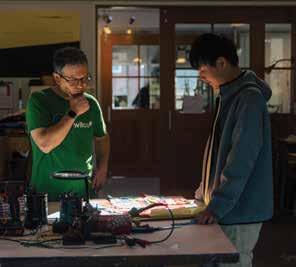
from the seventh grade, each year building upon the prior year. Students in eighth and ninth grade can continue a general art class or choose an intensive studio art class, where they focus on one skill for a longer period of time, such as pottery, 3-D contemporary art, wood carving, or set design.
“At IMS, we’re lucky to have flexibility,” Mr. Pecchia says, “I can take my students on different artistic journeys whenever the opportunities arise, and they arise often. I love it when one of my students realizes that they have potential and can make art at a level much higher than anyone expected.”
Through their work, students are learning essential life skills: problem solving, self-evaluation, time management, and being part of a team. “That’s what art is about,” adds Ms. Jenkins. “It teaches resilience, grit, and forgiveness. A so-called mistake may be what truly makes the piece.”
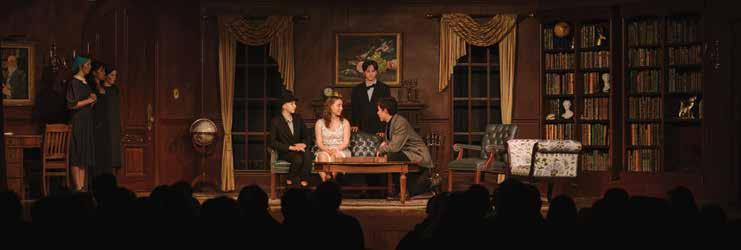
Updating a 1922 Classic
In honor of the IMS Centennial, our performing arts students in grades 5–9 rewrote and staged a version of the 1922 melodrama, The Cat and the Canary. With stunning, transforming sets built and painted by Mr. Pecchia’s fall elective students, and Danny Tieger’s artful and comedic direction of the remarkable performers, this 100-year old thriller was made relevant and exciting. Every year, students can participate in the fall play and the spring musical, each production combining the talents of the entire IMS Arts team.

Patterns of American History
Art Students Embark on a Thought-Provoking Study
By Amy Jenkins, IMS Art Teacher
Through the winter term, all of us in the IMS Art Department made a commitment to study, craft, and immerse ourselves in the deep history of the Gee’s Bend Quilters. The Quilters and their resulting work are deeply rooted in ancestral visual memory, the hardships of enslaved peoples, and the resilient spirit and beauty built upon reworking and repurposing worn work clothes, castoff scraps, and flour and cornmeal sacking. We explored and discussed the family histories of the contemporary quilters, the fact that these families were on the same land their enslaved ancestors worked, and spoke of their importance and place in contemporary art today.
What was unexpected was how deeply the students would embrace our journey with their own building of quilts. Students learned several basic hand stitches, learned how to piece and assemble their own squares, embraced restitching when a wrong turn was made, and learned how to keep going even when fingers were pricked. Over the course of the term, students helped each other and fell into deep conversation while sewing. Students who ran out of one fabric could understand the perfect imperfections inherent in the Gee’s Bend Quilts, and slip a different scrap in.
This project not only challenged our students to learn a new creative skill, it also challenged them to explore the historical context of what they were producing and its relevance to who we are today. We always planned it to be thought-provoking, but never predicted how impactful and all-encompassing it would become for both students and teachers.
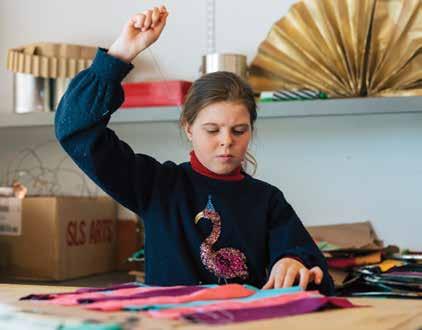
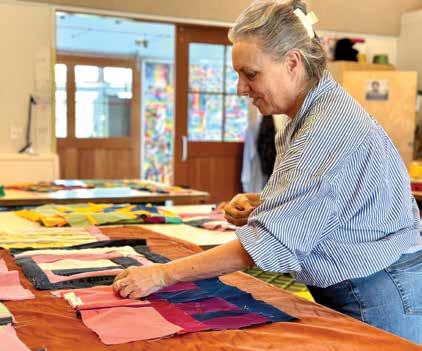
IMS Athletics
Our Falcons in grades 5–9 participate in a different sport every season, either learning new skills or competing at a high level. Go Falcons!
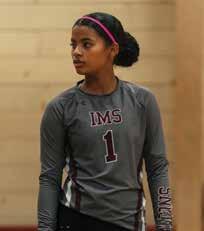

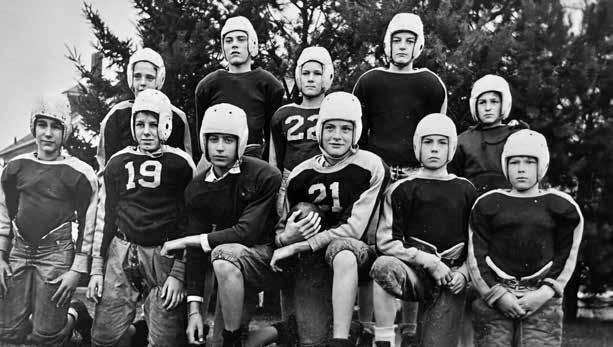
From the archives: IMS football team, 1944

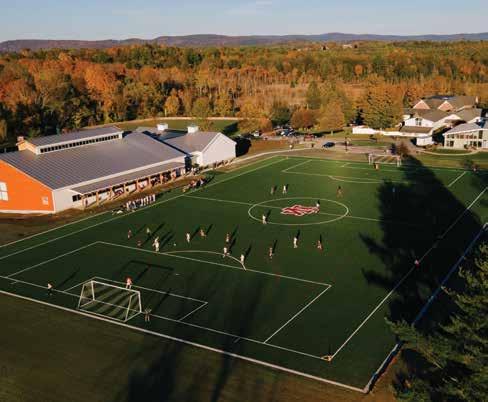
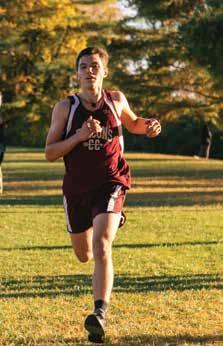
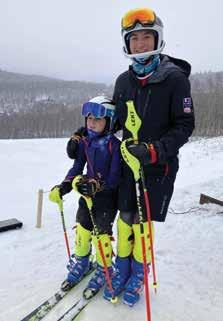
Centennial Field
Our new turf field was generously donated by Lou and Kathleen Hager in honor of Robert Whitaker “Whit” Hager, Class of 2021. The field was officially put into play with two home games during our Centennial Celebration in October, 2022.
“Sports have been a big part of my life and have taught me valuable life lessons: there will always be obstacles, and it’s what you do to persevere and overcome them that counts.”
Marcus Paul, ’23
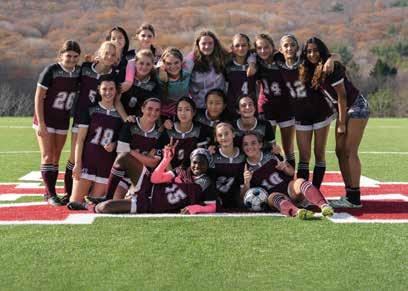
Undefeated
Why Is This Team So Good?
It’s a chilly afternoon toward the end of the fall season, and the IMS Girls Varsity Soccer team is getting ready for a game with a pep talk from Coach Kyle Halloran and Coach Colleen O’Reilly. There’s tension in the air and the team is nervous. They haven’t lost a single game in five years.
“It’s not about the streak,” says Coach Halloran.
“It’s NOT about the streak,” emphasizes Coach O’Reilly.
But nerves are still high. There’s only one thing for it: Just Dance! Coach cranks the music, and in seconds, everyone is dancing with abandon and laughing with each other. No more nerves. The team finishes out the season with the winning streak intact.
by our athletes’ sportsmanship, work ethic, and play; never their physical makeup or their final score. We often say “it’s a number, it’s not you.” It’s amazing how empowering that statement can be.
As coaches, we aim to develop confidence in each of our players, both as athletes and as individuals. We speak with our team often about the importance of leadership, particularly female leadership, and how the skills learned in practice will stay with each player beyond IMS.
The pressure this team manages as they continue to extend the unbeaten streak (now at 66 games) is considerable. Legendary UCONN women’s basketball coach, Geno Auriemma, says that “With the absence of pressure, it’s hard to do great things.” While we as coaches are not worried about continuing to win for the sake of the streak, we certainly appreciate the confidence, resilience, and poise our players develop as a result of the pressure they have to manage. We have no doubt this experience is turning them into great people.
It may seem cliché to say “there is no ‘I’ in TEAM,” but for us, that couldn’t be more true. In sports, there’s often a star player or two, but they are only as good as the team that supports them. We are a team made up of fifth through ninth graders, which is a really wide age range. Our older players are encouraged to pair up with younger players to serve as mentors throughout the season. We try to foster an inclusive team culture where you are accepted and valued for who you are and how hard you work, not how talented you may be. It helps build confidence and self-esteem in every one of our players, which ultimately leads to success on and off the field. As those younger players hone their skills, they rise up to become the mentors for the newer team members.
By Kyle Halloran and Colleen O’Reilly
IMS Girls Varsity Soccer is special. The team’s five season unbeaten streak is certainly impressive, but it’s not just about stats and superstitions. The players and the energy that exist around this team and “the streak” are also special because of what these athletes represent. We’re well aware of the challenges professional female soccer players have faced over the years to gain equal respect and equal pay as their male counterparts. But at IMS, we strive to ensure all of our teams are on equal footing and accomplishments are measured

What About Bob?
For us, soccer practice is, in many ways, the best part of our day. We get to work with a group of athletes who take themselves seriously, want to work hard, and also know how to have fun. When our younger daughters come to watch the team play, we know they see themselves in these players. It is our sincere hope that each player will walk away from this team proud of their athletic accomplishments, appreciative of their teammates, and confident in their ability to take on any challenge they may face in life.
The Legend of Bob is a Girls Varsity Soccer team superstition that has gained notoriety over the past few years. “Bob” is a Bob Marley t-shirt worn by a 9th grader each soccer season. The player chosen each year embodies the spirit of the team. Bob attends every game of the season, worn under the player’s jersey, is kissed by each player on the team before each game, and is signed by all who have worn him. Another part of the superstition? As long as the team is winning, Bob can’t be washed!
Morehead Athletic Center
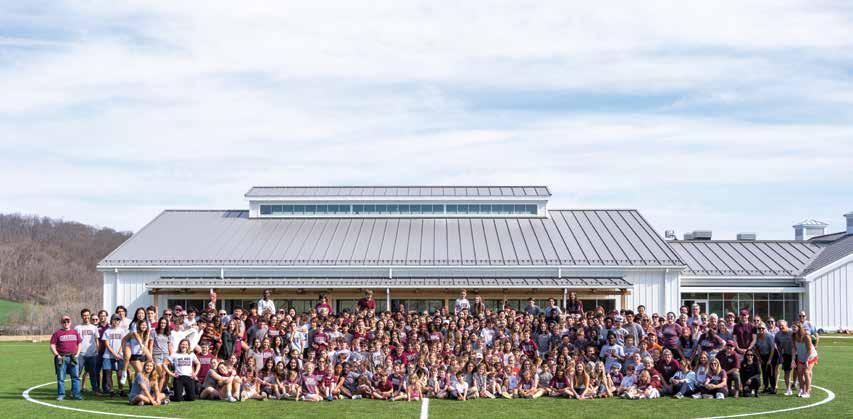
Where Athletics and Community Combine
The Morehead Athletic Center officially opened for use on April 14, 2023. This stunning addition to our campus boasts two basketball courts and multi-use space, four international-size squash courts, a spectator viewing gallery, fitness center, and training room. It’s not just a place for athletics — it also serves as a sizable indoor facility to host both campuses for all-school events, and it provides our boarding students and faculty with additional places to gather and play on the weekends.
The Athletic Center is named after Dan and Devon Morehead, parents of Emmett Morehead ’17. Now a successful quarterback at Boston College, Emmett has described his time at IMS as one of profound personal growth, contributing to his current success. He joined us for the ribbon cutting ceremony during our Centennial Celebration in October 2022 (see following pages).
The Morehead Athletic Center is a team effort, and we thank all of the donors who helped make this extraordinary building possible.
“When I first began here six years ago, we started talking about an athletic center and what it could mean for IMS. Now it’s actually here, and it’s even better than I could have imagined. This is a game-changer.”
Max Abendroth, IMS Director of Athletics

The entire school gathered on the new basketball courts to celebrate the grand opening.

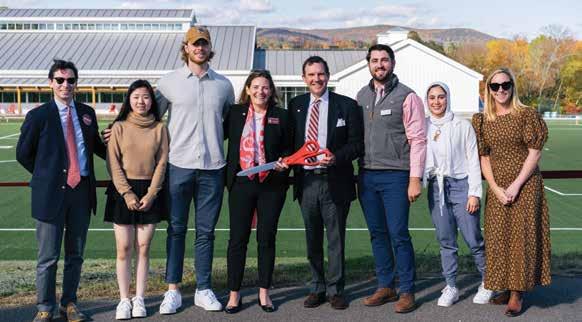
Happy Birthday, IMS!
This year has been, without a doubt, the biggest milestone in the history of Indian Mountain School. We celebrated our founding all year long with friends around the world.
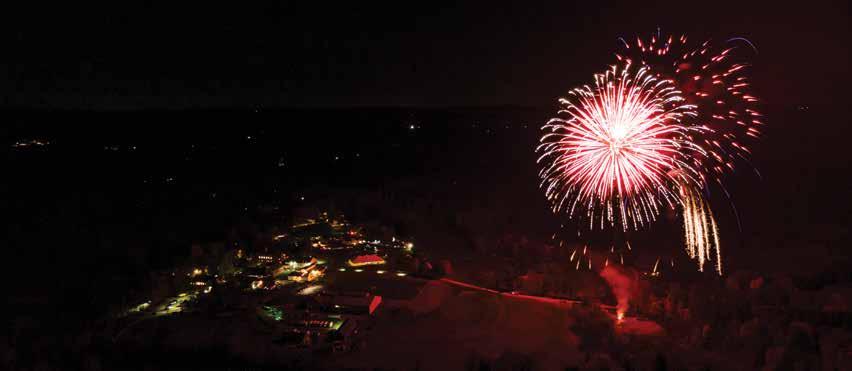


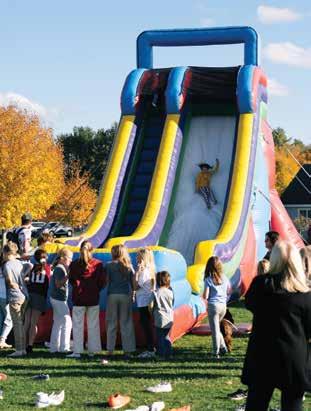
Hundreds attended Centennial Weekend at IMS, our marquee event. We held a ribbon cutting ceremony for the new Morehead Athletic Center, followed by athletic games, family fun, music, and fireworks.
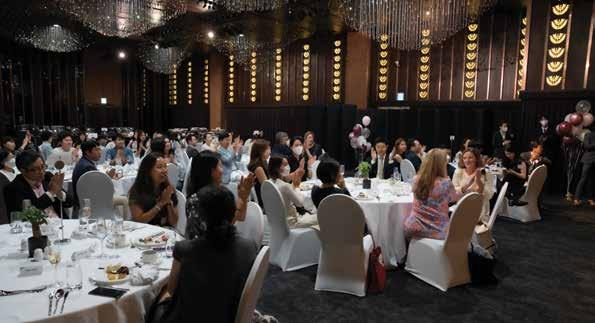
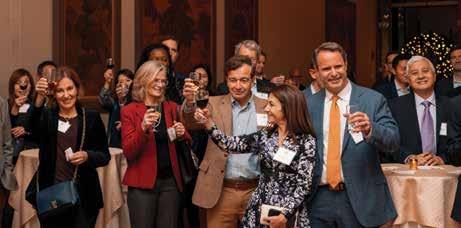
We celebrated with alumni, trustees, and parents at the Harvard Club in New York City.
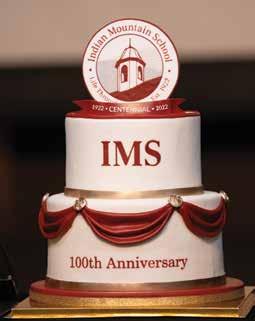
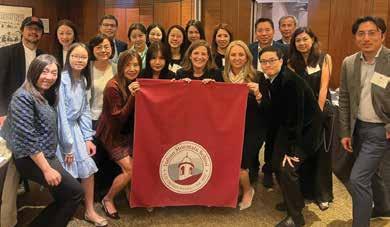
We gathered with friends and families in Hong Kong.
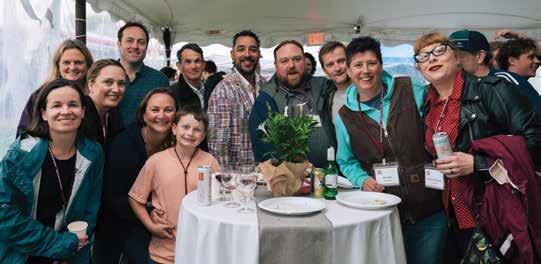

We saw record-breaking attendance at our spring Centennial Alumni Weekend. It was heartwarming to see so many familiar faces return to the mountain. Campus came alive with an evening of talented alumni bands and musicians, reuniting with Music Department Chair Ram Miles.

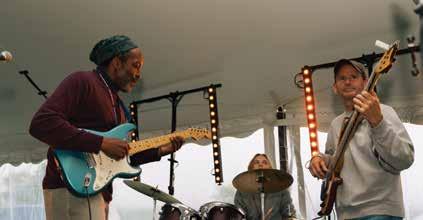
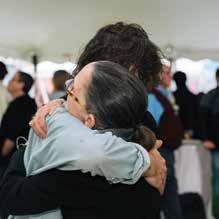
The Korean Parents Association hosted a joyful celebration in Seoul.
Cente nnial Cl a ss
“You are now a part of IMS history as much as IMS is a part of your history. You have built strong relationships, taken risks, honed your talents, and deepened your reservoir of courage and knowledge.
Through it all, you have reminded us to maintain a sense of humor and joy.”
Jody Reilly Soja Head of School
“This finish line is not the end, but rather, the first in a long line of achievements yet to come.”
Ninth Grade Class, “This We Believe” Commencement 2023

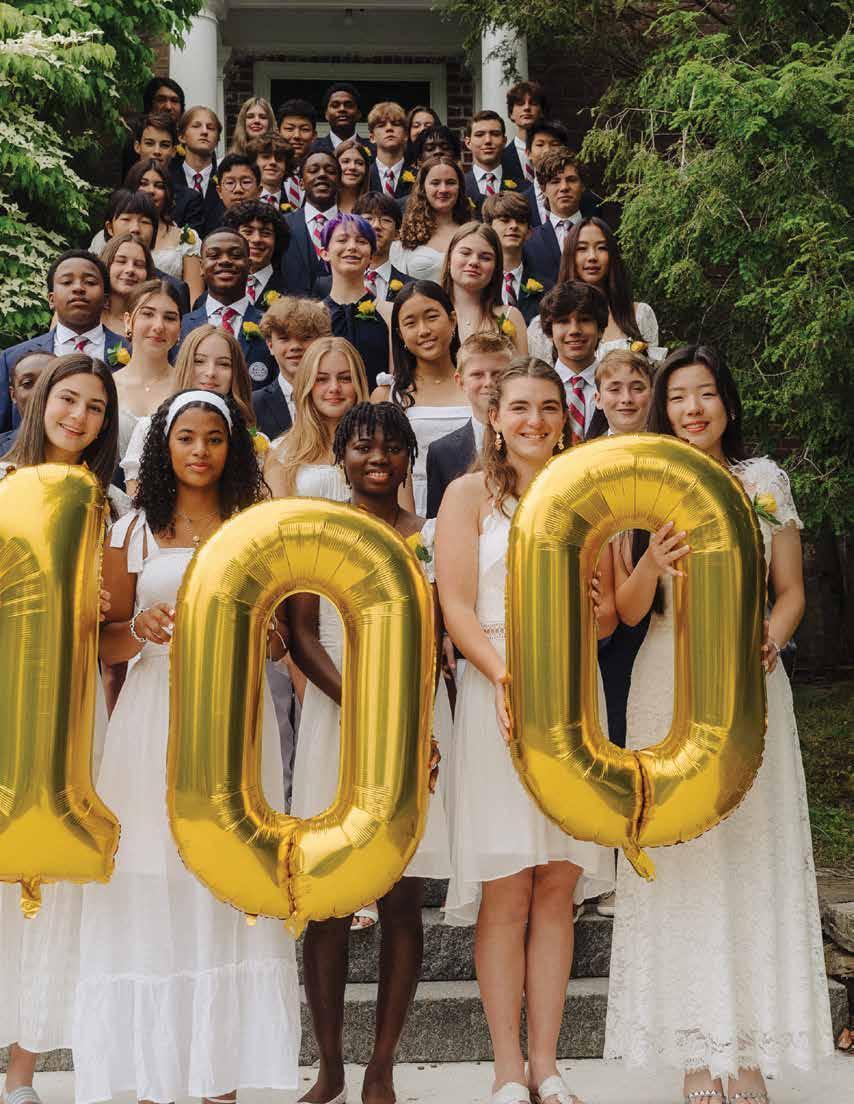
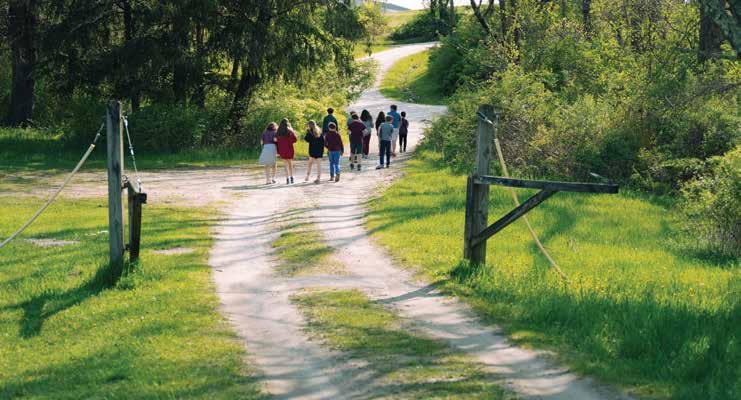
Stewardship and the Sublime
A Vision for Sustainability
Throughout the year, Tom Stewart, our Director of Sustainability Programming and Initiatives, held several talks with the community about our relationship to, and stewardship of, the natural world. Mr. Stewart shared the following reflection with us in September 2022, setting the stage for our important ongoing work.
Stewardship is the word for acting with the obligations and responsibilities of a steward. You may have heard that word used in the phrase “a steward of the land.” A caretaker, of sorts. The concept of being a steward is found in nearly every culture in the world. In fact, many indigenous cultures lack an equivalent word in their language because the concept of stewardship is so vitally ingrained in cultural practice that there is no way to express it as a separate way of being. What better peoples could there be — to be entrusted with the protection of such an important aspect of the planet — than those that see themselves as indistinct from the environment around them?
Stewardship is not new to IMS. The founder Mr. Riggs’ original idea was to have a school dedicated to learning as much from the land as from books. In addition to studying Latin, geography, and history, the early students on this campus studied soil, and the life-cycle of things that grow from the
earth, and how to care for a variety of animals. And from that time to now, the school has held up caring and service as a core tenet of its philosophical grounding.
What does it mean to be a steward these days, and what does stewardship mean in a modern, broad sense?
I think the starting point is that concept of being a caretaker — but it is more than just caring. It is about caring that is rooted in a sense of connection and in a sense of responsibility. Why do we care for some things more than others? There are some obvious things like familiarity and perceived value that make us care, but I want to look at something not typically considered, and I think is extremely important and, maybe, the core of it all: beauty, or more precisely, our ability to appreciate beauty.
When I say “beauty” I’m not thinking of the surface attractiveness of things, but something far deeper. I have a daughter who is studying philosophy at university and last year she was talking with me about a paper she was writing about truth, beauty, and something referred to as the sublime According to one dictionary the sublime “inspires deep veneration, awe, or uplifting emotion because of its beauty, nobility, grandeur, or immensity.” This is not your everyday encounter with something pretty, but rather that occasional experience that you find moving or amazing in some way — a double rainbow, an incredible sunset, or the sun shimmering through trees glazed after an ice-storm.
Why focus on beauty and this word “sublime” in a

sustainability talk about stewardship? It is because opening ourselves up to experiencing the sublime, this kind of beauty, allows us fleeting glimpses into how we are all connected to the awe-inspiring world we inhabit, and through that recognition we get a view into how we are all connected to one another.
There are many, many ways to find such beauty and truth. It is literally everywhere. Scratch the surface of any science and you will find the sublime. Exploring physics reveals comprehensible laws that govern the universe, laws that dictate what happens at the core of a sun and in the atoms of your finger tips — amazing! The study of astronomy might put you under the arc of a night lit by billions of stars and as you glance through the edge of the Milky Way galaxy, you rotate and revolve through limitless space at nearly 900,000 mph. And then there is biology. The improbable dance of time and tiny, random change that has resulted in the evolution of the delicate, but also somehow robust, amazing Muir Web that is the biosphere of which we are a part and which we mistakenly have seemed to claim as our own. The discovery of just how completely connected all life is and the incredible happenstance of our existence is certainly of the sublime.
Beauty and truth, of course, are rightfully seen as the domain of the arts — human-made echoes of the sublime that surrounds us. A drawn line that perfectly describes its subject; a line of poetry that somehow conveys the poet’s sense in a set of words that at first glance seems far too inadequate; an actor’s voice that delivers truth in the midst of the stage’s artifice; the magic universality of the harmonies and notes of music.
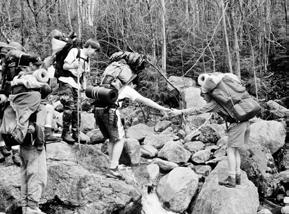
Draft of the IMS Sustainability Mission Statement
As members of the IMS community, we have an individual and collective responsibility to be stewards of this land and of the broader world. The School is therefore committed to providing students with the moral framework, understanding, and skill set necessary to address the challenges currently facing our planet. We recognize that the changes to the planet systems brought about by human activity tend to affect marginalized peoples first and more severely. And so, we understand that sustainability work is work toward justice, and that it is in direct conversation with our diversity, equity, and inclusion efforts. As an institution, IMS will strive to minimize its environmental impact and will encourage faculty, staff, students, and families to consider their own ecological footprints and, wherever they are, to become better stewards of the planet and of the future.

Ninth grade boat trip off the coast of Maine
From the archives: outdoor adventures, 1970s
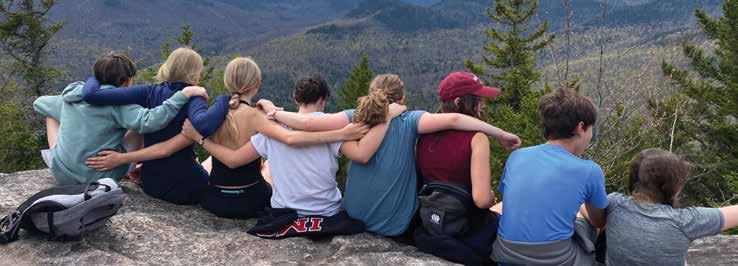
Opening ourselves up to experiencing the sublime allows us fleeting glimpses into how we are all connected to the aweinspiring world we inhabit.
The sublime is found in other endeavors as well. Athletics is, from the arc of a soccer shot, to a perfect ski run, to the return of a serve, the astounding intersection of human physiology and those same laws that describe the orbit of planets. The story of a team coming together over a course of a season, or an individual so in tune with their own biology that they can act with complete precision and control under pressures that would defeat everyone around them.
Maybe most importantly, the sublime is found in the tremendous acts of compassion, endurance, selflessness and care that appear throughout the story of humanity and that have been the true driving force of its progress. Yes, that story is also filled with pain, fear, suffering, and cruelty, but there is clear evidence that the long, moral arc is in fact bent by those acts of humanity, and not by inhumanity. And it follows that in our own histories we personally progress through our acts that echo and harmonize with the truth and beauty we see around us. Where we fall short is in the moments when we lose our sense of connection and forget where our responsibilities lie. So, open up to the sublime. Be ready to recognize it. That is a very tall order these days. We are built for distraction. Our twitchy reactions to deviation from the routine was our salvation once, and kept us from being eaten by faster and stronger animals. But even now, safe at the apex, we struggle to move past responding to only the most immediate stimulæ. In our wired, networked world it seems nearly impossible to find a slow, quiet moment, and the sublime takes time, requires patience and stillness. This is, in part, why IMS has the Outdoor Adventure and Education program, why we have the OWL, why we interact with our mountain in the ways we do. It is also why we teach what we do and why we teach it the way we do. Much of the curriculum at school can be a gateway to finding the amazing ways the world is connected.
Here is what I hope for us all: that every day we are witness to something amazing. Right now that might be ambitious, but open yourself up to it at least once a week to start. Maybe you step outside on a night so filled with stars that you’re pretty sure you can see your shadow by their light. Maybe you watch an uncommon moment of compassion enacted by someone you barely know. Maybe you are amazed to learn about the way that trees communicate with each other through the mycelium network beneath them, or about the intelligence of octopuses. Maybe you are awed by stories of people sitting at a drugstore counter waiting to be served, or how a math formula on a page can describe the arc of a bridge. Whatever it is, be open to seeing it.
And if we can begin to regularly recognize the everyday sublime (which I suppose is a contradictory phrase), the kind of caring for the planet and its inhabitants that is needed today and for the future will follow without a doubt. We protect what we care about. We care about things we value. We value things we find unique and amazing, beautiful and true — the sublime. If we do not seek to become stewards of our planet, we each run the risk of unthinkingly acting from not only an anthropocentric, a human centered, position of privilege that disregards the rest of the biosphere, but also a “now-centric” privilege that does not consider generations yet to come. And we also run the risk of failing to recognize the injustices rooted in the nexus of extraction, gain, and future and current climate suffering. We all must look for connection and embrace our responsibility. Be humble and become an indistinct part of that which you seek to save. Look for that truth and beauty. Be amazed by it all. Be guardians of our sublime home, our world.
We all must look for connection and embrace our responsibility.

Following the Forest
IMS Green Team Proposes Land Easement to Protect Forest Linkages in the Northeast
It may seem like a tall order to protect woodland areas in the Northeast from harmful development and forest fragmentation. But the IMS Green Team has planted roots at the Board level to protect a 64-acre parcel of our campus through what’s known as a “land easement.”
On June 1, 2023, five members of Ms. Kelly Tieger’s Green Team stood in front of the IMS Board of Trustees and presented a compelling proposal (drafted by the entire Green Team made up of fifth, sixth, and seventh grade students) to keep the parcel of land undeveloped in perpetuity. “It was incredibly empowering for these students who had spent their entire school year researching conservation, biodiversity, and our responsibility as human beings to protect the earth,” reflects Ms. Tieger.
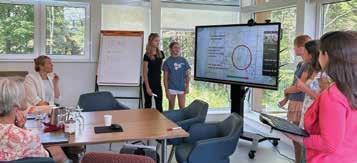
During their presentation, members of the Green Team stated, “a land easement at IMS would allow the school to create a legacy of conservation and put our sustainability beliefs into practice. We would be protecting a portion of our land forever — for the next hundred years, and the next, and the next.”
This type of ambitious yet critical work has gained momentum in the region thanks to an organization called “Follow the Forest.” In fact, it was during a 2021 visit from Follow the Forest and the Sharon Land Trust that IMS students began to imagine how they could preserve part of our own land to aid in the effort to prevent the persistent threat of forest fragmentation.
Over the past two years, Ms. Tieger’s students studied the Eastern Forest Corridor and drew connections between land development and habitat loss, and the subsequent ecological impact. Mobilized, her students and the Green Team were eager to learn more about wildlife linkages and how important they are for animals to pass from place to place, uninterrupted. “They became community scientists,” exclaims Ms. Tieger, adding that her students “collected data and performed linkage assessments right here on Indian Mountain Road.”
This timely and relevant learning experience began as a visit from local conservation organizations and will likely culminate in the lifelong protection of a parcel of land, proving that you’re never too young to make a tangible difference. The IMS Board of Trustees was excited to consider this proposal and will actively work with the Green Team on next steps.
Learn more about connecting and protecting forests: www.followtheforest.org

Members of the Mountain Sustainability Council, a.k.a. the Green Team
Boarding Life
Our beautiful campus is home to nearly 100 students from across the country and the world. Living on campus can be an invaluable growth experience. Lasting bonds are formed through shared adventures, busy days help develop fundamental time management skills and self-reliance, and opportunities for exploration and leadership abound.
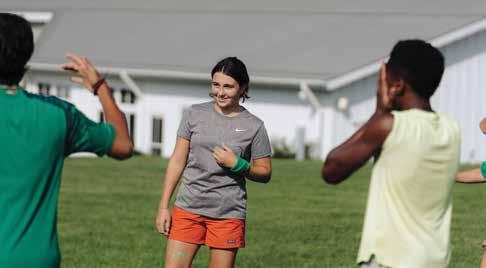
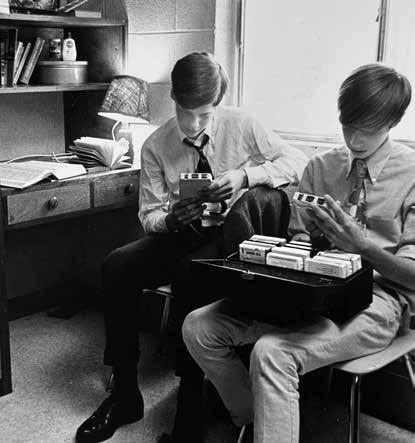
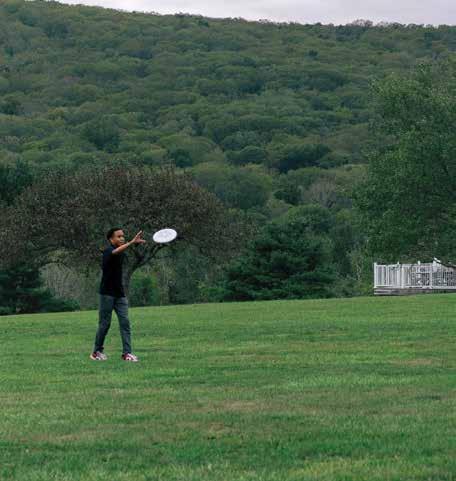
“Going to another place in the world, making new friends and memories; I didn’t realize that it would be the best experience I ever had.”
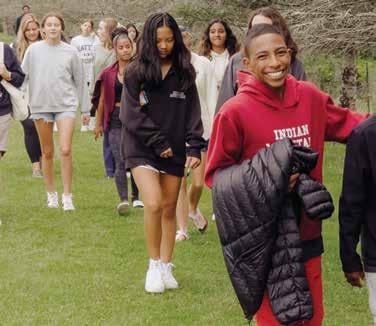
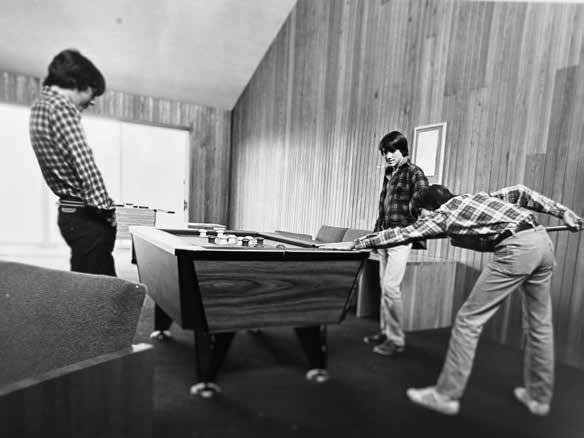
Julia Van den Braak ’23
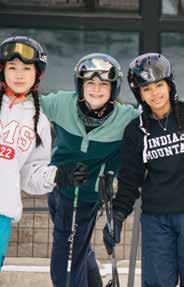
From the archives: Dorm life in the 1970s and 1980s – 8-track tapes and games of pool

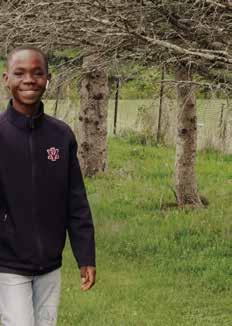
“At IMS, you will always find someone who will grow alongside you and help you become a better person.”
Jose Jiménez Rodríguez ’23
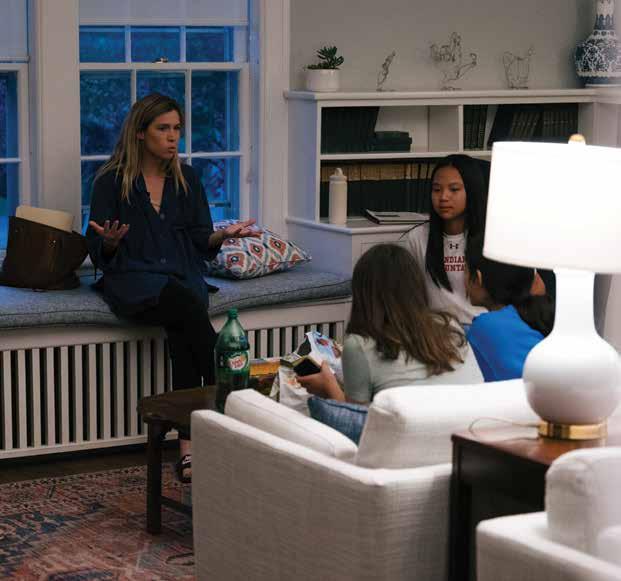
Living in a Tight-Knit Community
When a student first arrives on the IMS campus as a boarder, our priority is to make the transition from living at home to living on campus a smooth and well-supported one. IMS has several ways to help students feel at home.
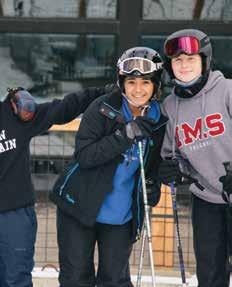
Settling in, making new friends, and establishing good routines is not always easy. As the year progresses, students have touch points to help them navigate their academic and personal lives. The Fireside Chat is a recurring opportunity for residents in a single dorm to gather with a member of our counseling team and talk about anything and everything.
Often, what may begin as a general discussion about schoolwork or sports can evolve into more intimate and thoughtful exchanges between students, during which they bravely share personal reflections, experiences, and
insecurities. Their willingness to engage and be vulnerable along with their respect for one another makes for a rewarding hour. Students develop an understanding of diverse viewpoints and also feel a deeper sense of support and belonging that comes with living in a tight-knit community.
In the Classroom
History’s Mysteries
Learning From Objects
This year, students in our history department elective focused on the 100-history of the school. In “History’s Mysteries,” students visited the archives and combed the campus to locate IMS artifacts that tell a story about the school’s past. For example, the old bus engine on our mountain was once used to operate the school ski slope rope tow. Students found other artifacts and organized corresponding photographs and articles and shared their findings during one of the morning meetings and in a display at the Alumni Centennial Exhibit during Centennial Weekend.
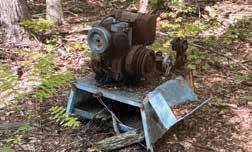

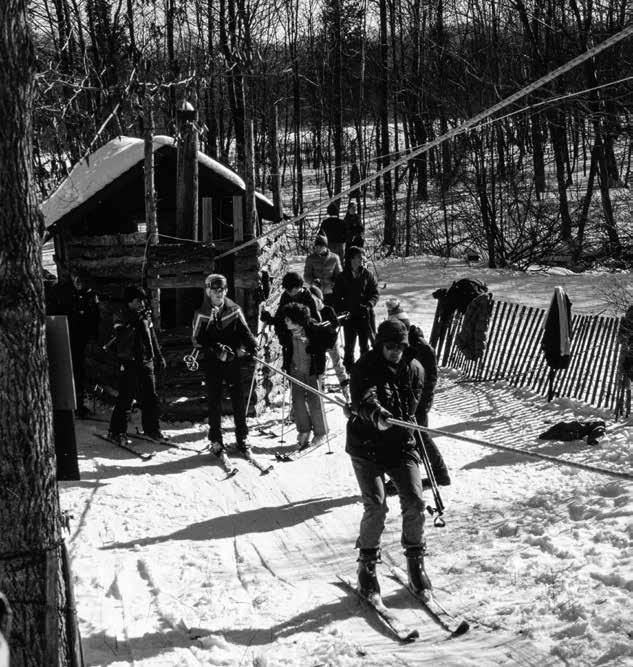
Outside the Matrix
New Computer Programming Class Tackles World Issues
This year, we added a new course to our tech curriculum called Advanced Placement Computer Science Principles. Under the guidance of Mr. Jason Barillaro, Director of Academic Technology, students alternated between project-based work and discussion. Once a week during this year-long course, they stepped away from their computers and spent time investigating a range of topics such as network and security, issues of Diversity, Equity, and Inclusion within the tech world, and the implications of emerging artificial intelligence.
“These are big issues, and ones that often carry the heavy weight of concern,” Mr. Barillaro says, “but the discussions we have are really enlightening and the students have such solution-oriented thinking. They are creative and open to each other’s ideas and they are very interested in what’s happening in the world to address those issues.”
Left: The old bus engine today
Right: From the archives: The rope tow in action
Critical Thinking
Socratic Seminars in the LAD Classroom
Once a week, in Mike Wilson’s Language Analysis and Development (LAD) classroom, students engage in lively dialogue as part of the Socratic Seminar. This year, they tackled complex themes in Elie Wiesel’s wrenching autobiography, Night. Referring to their annotations, students presented their opinions, shared insights, reacted to and built upon each other’s viewpoints. Students are not only assessed on their contributions, but also on how actively they bring others into the conversation, thereby making it inclusive for everybody.
“The Socratic Seminar is a very egalitarian way to make the content and analysis of material more accessible,” says Mr. Wilson. “For some students, writing can be the hardest thing to do. So, rather than worrying about punctuation and grammar and the very structured process that writing calls for, my students can really explore the things they’re learning about through discussion.”

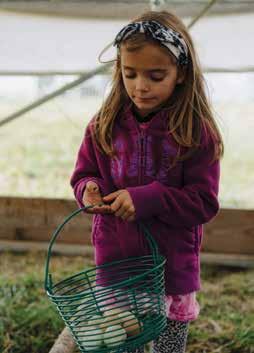
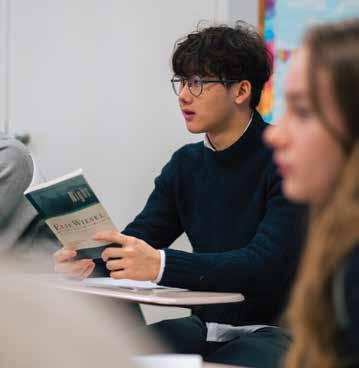
The result of these classroom discourses is that students crack open complex ideas and are able to examine not just what they think about a text, but how they think about it. By engaging in intellectual discourse about challenging themes such as loss of faith, human cruelty, and stereotypes, students are able to open their minds to different perspectives.
“Sometimes I think of this exchange of ideas as an affirmation of humanity,” says Mr. Wilson. It’s honestly my favorite class to teach and I really hope the students walk away feeling engaged and self-illuminated.”
Stewardship
Starts in Pre-K
Seasonal Visits to Local Farm
Our relationship with — and stewardship of — the land has been an integral part of the learning experience at IMS since its founding in 1922. This year, our Lower School students spent each season visiting Fairfield Farm at nearby Hotchkiss School. They learned about organic, sustainable agriculture and how that relates to environmental and personal health. In the spring, they showed extra enthusiasm when it was time to cultivate the Lower Campus Community Garden.
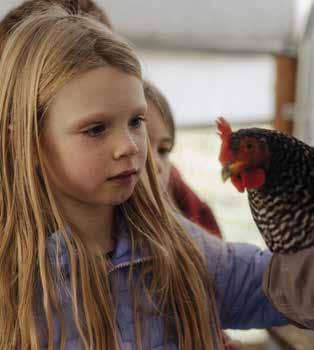
Community Collaborations
Collaborating with local cultural institutions is part of the IMS experience, broadening our classroom reach to include the exceptional creative and intellectual resources in our area.
Making Music with Bard College
In a series of workshops throughout the year, musicians from The Orchestra Now (TŌN), a graduate-level training orchestra based at Bard College, spent time with our Intermediate and Advanced Ensembles to talk about their paths to professional musicianship and to discuss their instruments of choice.
The musicians also treated the entire IMS community to a chamber music performance, during which they played an impressive and complex piece composed by IMS ninth grader Jayden Lee.
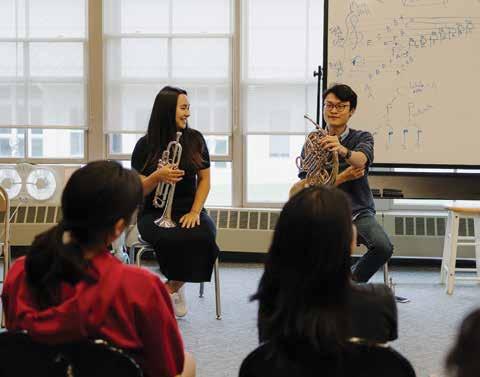
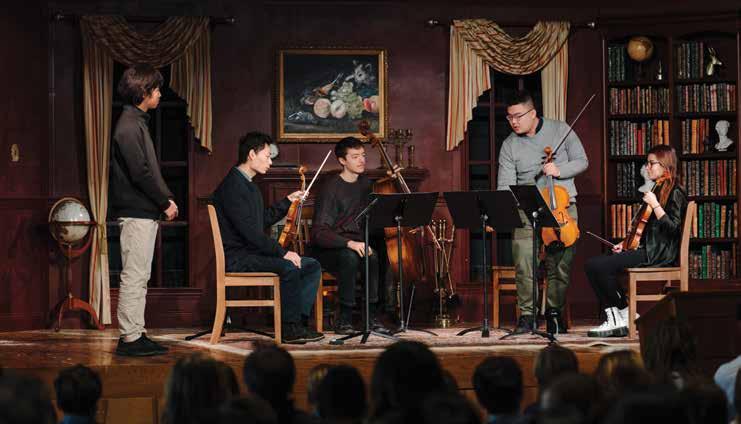
“It was
so
inspiring to see the
dedication of the TŌN musicians to their craft and also their love of music. I think this was a profound experience for our students.”
Judith Dansker, Director of Classical Music Studies
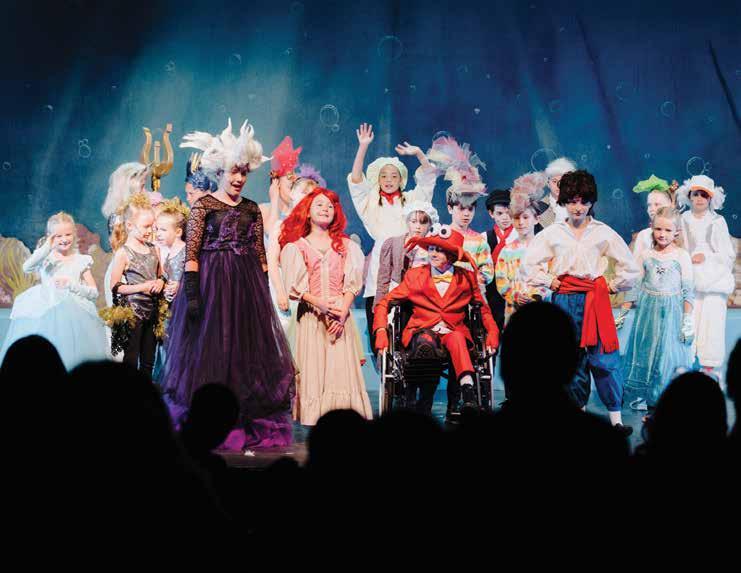
The Power of Theater
Sharon Playhouse Partnership
The Sharon Playhouse is a not-for-profit theater and popular New England cultural destination. Located in neighboring Sharon, CT, IMS is fortunate to benefit from an ongoing partnership with the talented team of Playhouse artists and educators. Each year, Associate Artistic Director and Director of Education Michael Kevin Baldwin and Company Manager and Education Associate Sarah Cuoco explore many aspects of performing arts with our Lower Campus students. Not only do they cultivate an appreciation for the arts in our young learners, they work with our third and fourth grade classes to write their own original plays, which are performed for families and peers each spring.
This year, in addition to our ongoing training and education at the Lower Campus, IMS students in grades 1–4 had an
opportunity to put on a production of The Little Mermaid Junior at the Sharon Playhouse. This extraordinary opportunity began in January as an after school elective offering and culminated in a professional musical theater performance. Our young students auditioned for parts, memorized lines, mastered songs and choreography, learned blocking, and in the final week spent time on the stage, under the lights, for a spectacular musical production. We are so proud of our young actors and extend a special thanks to the entire Playhouse crew, to our very own Tamra Stephenson for her musical direction, to producer Amanda Halloran for her tireless organization and encouragement of our students, and to the generous donor who made this possible.
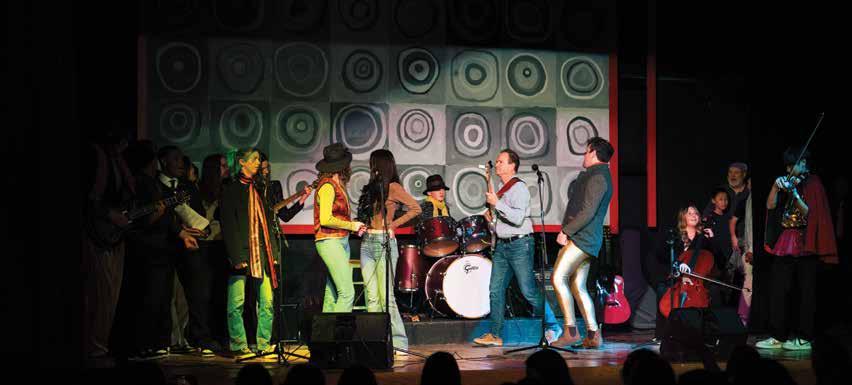
“From the first musical note to the final echo of the amplifier, it has been all about our kids connecting with other kids. These few measures of song plug our kids into the global community as a way to live our school motto: Life Through Service. The positive vibes are still resonating.”
Thomas McGlone, Musician, IMS Global Languages Department Chair
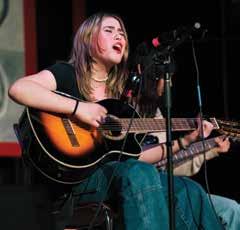
By Kids For Kids Turns Twenty
An Annual Tradition Makes a Big Comeback
After three years of pandemic-related cancellations, we were finally able to welcome back one of our most beloved traditions: By Kids For Kids (BKFK), a studentled concert that is a collaboration between our community service and music departments. This was our 20th Annual BKFK, and there were 20 acts in all: solo and group performances by students ranging from third through ninth grade, including faculty musicians — all showcasing the remarkable talent within the IMS community.
The goal of BKFK is to raise awareness and funds to help children with serious illnesses attend the Hole in the Wall Gang Camp in Ashford, CT (founded by Paul Newman in 1988). So far, IMS students have raised and donated more than $50,000.
Below: From the archives: BKFK “Unplugged.” A power outage in 2017 resulted in a fully acoustic performance lit by camping lights.
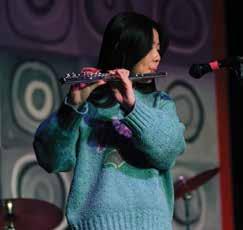
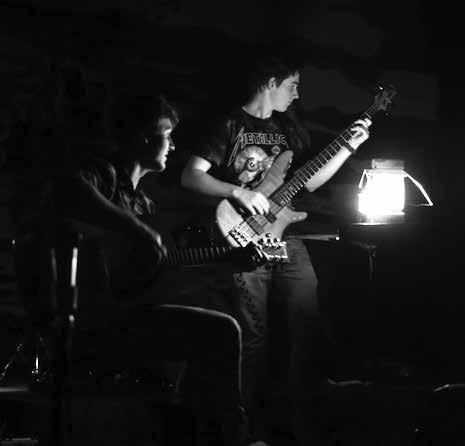

Growing Our Community Spaces
State of the Art Facilities to Match Our State of the Art Programs
Coming Soon: Performing Arts Center
Our performing arts program is a highlight of the IMS experience, and our exceptional theater and music curricula are enhanced by several community partnerships. Throughout the school year, we gather for plays, musicals, and concerts.
The addition of the Morehead Athletic Center (page 15) now allows us to reimagine our existing gymnasium as a state of the art performing arts center. It will be equipped with tiered seating, optimized acoustics and lighting, and a larger stage, making it our principal venue for our robust performing arts programs, as well as a gathering space for daily assemblies, visiting speakers and community events. “It’s exciting to watch the transformation of campus right before our eyes,” says Head of School Jody Reily Soja, “But we’re not investing in buildings just to enhance our facilities. We’re investing in the experience of our students, the growth of our program, and the sustainability of our school.” Thanks to the continued generosity of our donors, we anticipate a grand opening in the spring of 2024.
In the Future
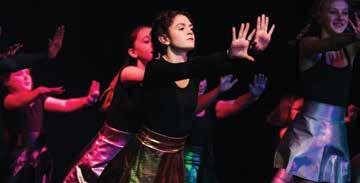
“This
is so powerful for students who identify with the performing arts. They feel like their passion is elevated and supported by the choices of the school and the generosity of our donors.”
Danny Tieger Performing Arts Director
We are in the planning stages of our next capital project which will further enhance the way our growing community learns and comes together. We plan to repurpose our current Assembly Hall into a new Dining Hall. Additional academic spaces, a larger Dining Hall, and a Wellness Center are next.
Building Upon Our Culture of Philanthropy View from Advancement
Inspired by our school motto of Life through Service, we have strived to build a strong culture of philanthropy and service over the last 100 years at IMS. With that foundation, IMS has grown, evolved, and is thriving. Celebrating our centennial year with alumni, parents, past parents, and friends across the globe in Seoul, New York, Hong Kong, Shanghai, Mexico, and Beijing was a joyful affirmation of the profound connection we all share to our beloved school; regardless of geography and in seeming defiance of time, it endures.
This year, we celebrated the completion of the Morehead Athletic Center and Centennial Field, our most ambitious capital projects in the school’s history. As we look to the future, our next capital project will allow us to reimagine our current spaces, by converting our former gym into a new center for community gatherings and performances (see page 31). None of this would be possible without you — our parents, alumni, and friends who support IMS, advancing our mission in support of IMS students today and for generations to come. Your partnership inspires the work we do on behalf of our students in the classroom, on the athletic fields, the stage, the mountain, and in our community.
Thank you for your service to IMS. We are deeply grateful for more than 500 donors who support IMS each year to ensure that our school reaches even greater heights in our second century.
Warmly,

Sarah L. Smith Director of Institutional Advancement
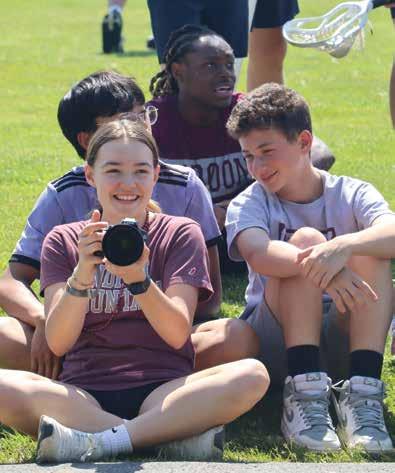
“As I walk outside on the campus and take in the views of the mountain and my surroundings, I do not take this opportunity for granted. Caring for a place is as important as caring for one another.”
Oliver Andreani Pandeff ’23
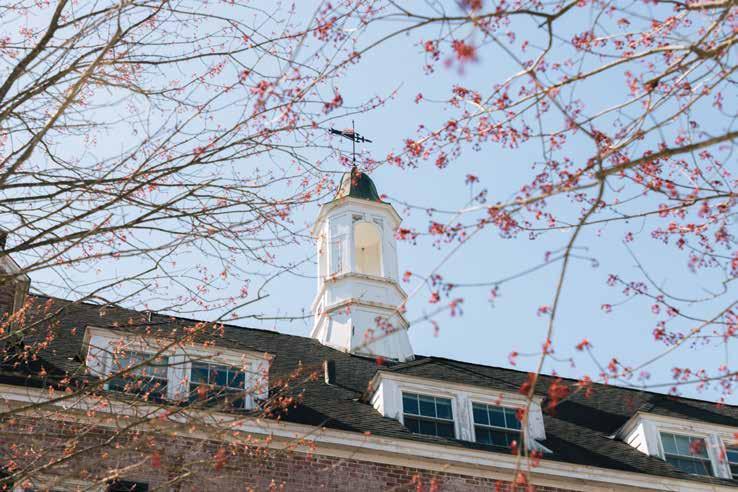
Donor Spotlights
This centennial year, the Office of Institutional Advancement reached out to a few of our donors to learn their thoughts on this milestone and why they choose to support IMS.
IMS Board Member JJ Velez ’96
“IMS was the catalyst for everything for me. Without IMS, there’s a very real chance that those other dominoes wouldn’t have fallen as they did. It’s also the friendships — so many that remain strong and vital to this day. My relationships with faculty and the positive impact they had on me are indelible. There’s also the diversity. I think there’s magic on the campus and magic in the hills. I have the fondest memories of the old traditions, and I’ll never get away from Maroon and Gray, but to see the way the school’s physical plant is evolving into a world-class facility is also affirming. I choose to be a part of the board and be an advocate for the school because I’ve witnessed first hand how transformational the IMS experience is, and that’s the main reason I remain active.”
Former Trustee Bill Landis ’78
“Giving is a very personal thing. If you’re an alum, as I am, I think you need to reflect on the arc of your life and where Indian Mountain fits in. For me, it was a fundamental building block. I’m fond of telling my kids (and anybody who asks me
about IMS) that I learned basically everything I needed to know in life between fifth and ninth grade at Indian Mountain School. The academic foundation, the socialization, the emphasis on empathy, and all of the experiences with sports and the outdoor adventure programs — it was a tremendous combination of different components that made it a very, very special place. That’s why I’m so passionate about it.”
Limin Kong P’23
“We spent the 2020 academic year, which was Tiffany’s first at IMS, weathering the pandemic in a small Hong Kong apartment. With Zoom classes going on in that tiny space, I was privy to everything, and I found the courses rigorous and engaging. Every teacher was excellent. It was such a silver lining in an otherwise challenging year. The following year Tiffany became a day student at IMS and she hit the ground running on all fronts: academic, social, athletic, music. It struck me how confident she was. All this confidence grew from the constant support of her advisor, her teachers, her coaches — all the mentors IMS had placed around her. The school has given Tiffany so much, so we’re happy to give back.”
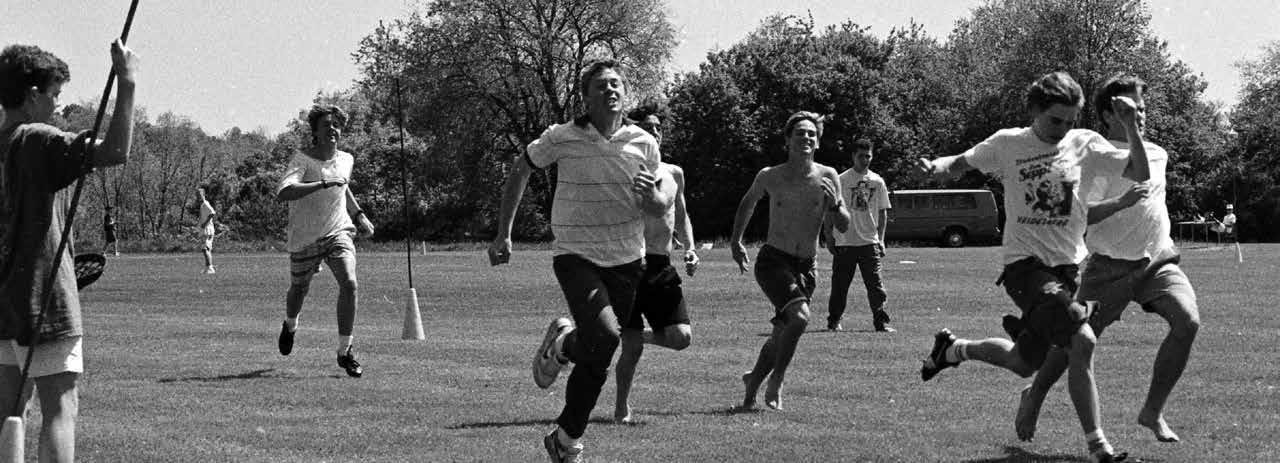
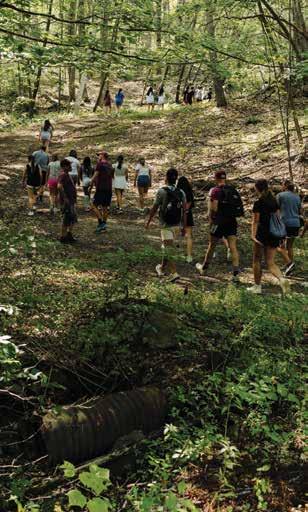
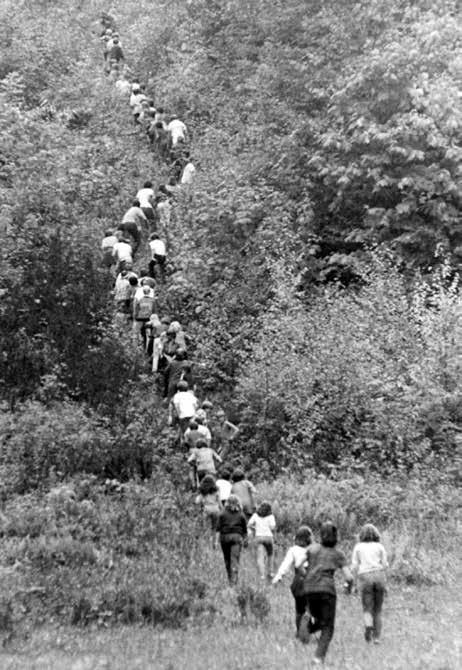
The Maroon and Gray Tradition
Did you know that the school’s first colors were actually red and white? The first documented references to the red and white colors were in 1926 and they did not change until 1940 when maroon and gray became the school’s official colors. The Maroon and Gray tradition began as a weekly competition in neatness, punctuality, and conduct. The first Mountain Day, when classes are canceled and the teams face each other in fierce but friendly outdoor games, was in 1939. These photos from past and present are a testament to this enduring tradition.
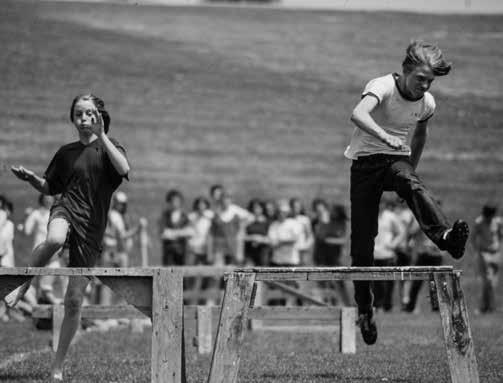
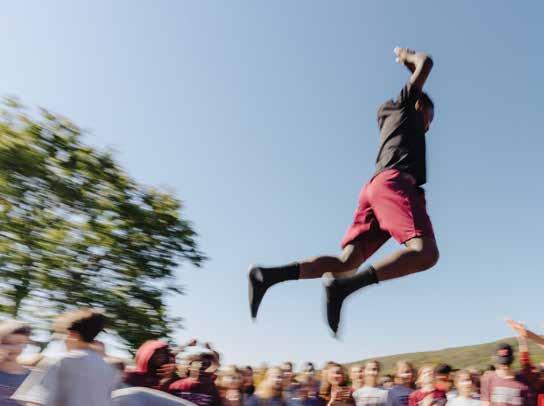
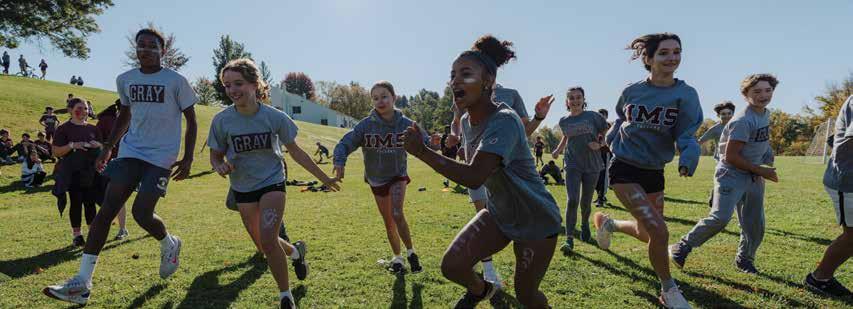
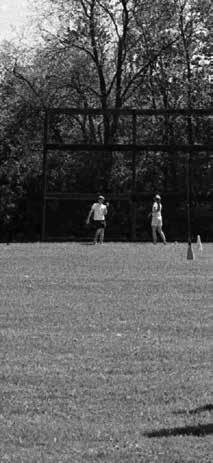

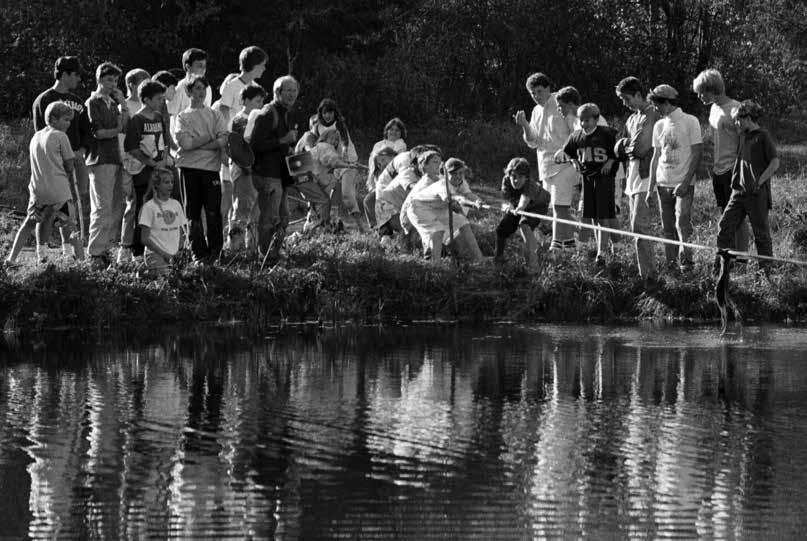
“Be grateful for the moments you laugh with your friends, be grateful for the memories you have made with one another.”
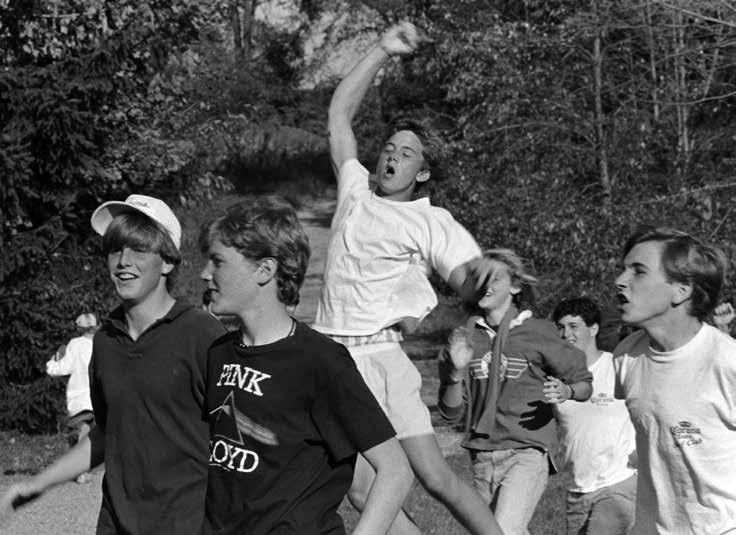

Wes Augustin ’23

How It Started...
Indian Mountain School was founded by Francis Behn Riggs in 1922 on the simple idea that education has the power to create change and end conflict. Originally known as The Riggs School, Indian Mountain School began as a working farm and school for “boys of modest means.” Students studied core academic subjects, agricultural practices, and the importance
of selflessness and giving back. Their education was rooted in traditional learning experiences and drew on the natural beauty and resources of the land. The motto “Life through Service” was at the core of the School’s mission, and continues to guide the program and experience at Indian Mountain School today.
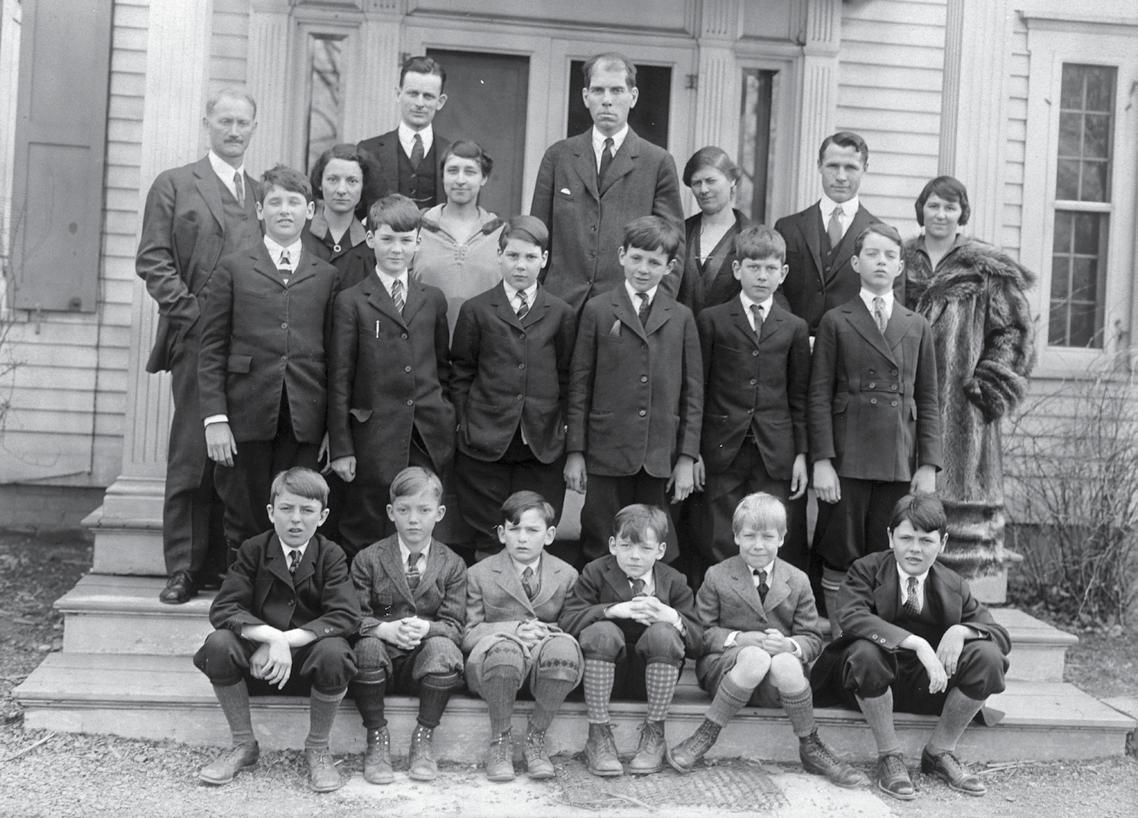
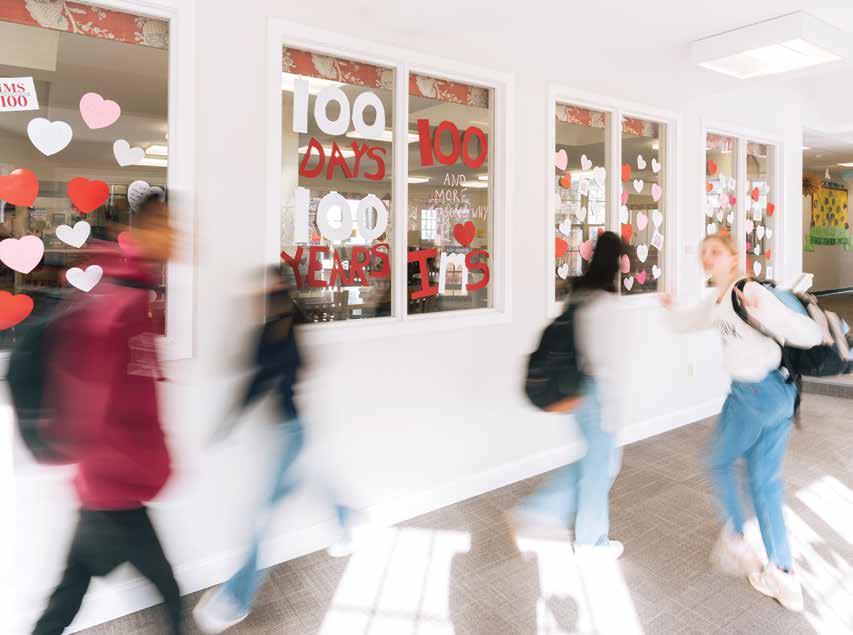
How It’s Going
100 Years — 100 Reasons
Many schools mark the 100th day of the academic year with various activities, and at IMS this year, marking the 100th day of school in our 100th year was particularly meaningful. To celebrate this once-in-alifetime day, our campus windows were decorated with paper hearts and on each one, students wrote about why they love IMS. Browsing through the hearts, you’ll see things like: “the inclusive community,” “my friends,” “the mountain,” “kind teachers,” and, “soccer season.”
We’re so grateful for the deep connections that have bonded our community. They are stronger than ever as we embark on our next century.

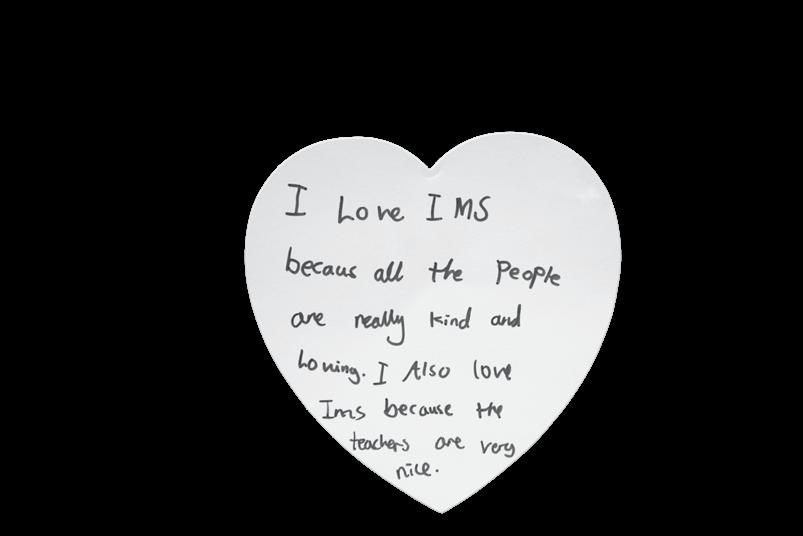
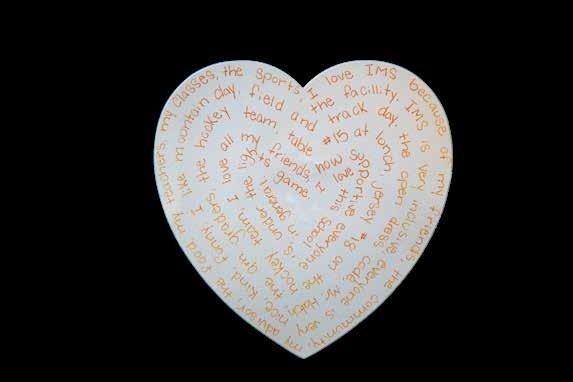
Indian Mountain School
211 Indian Mountain Road
Lakeville, CT 06039
(860) 435-0871
alumni@indianmountain.org www.indianmountain.org
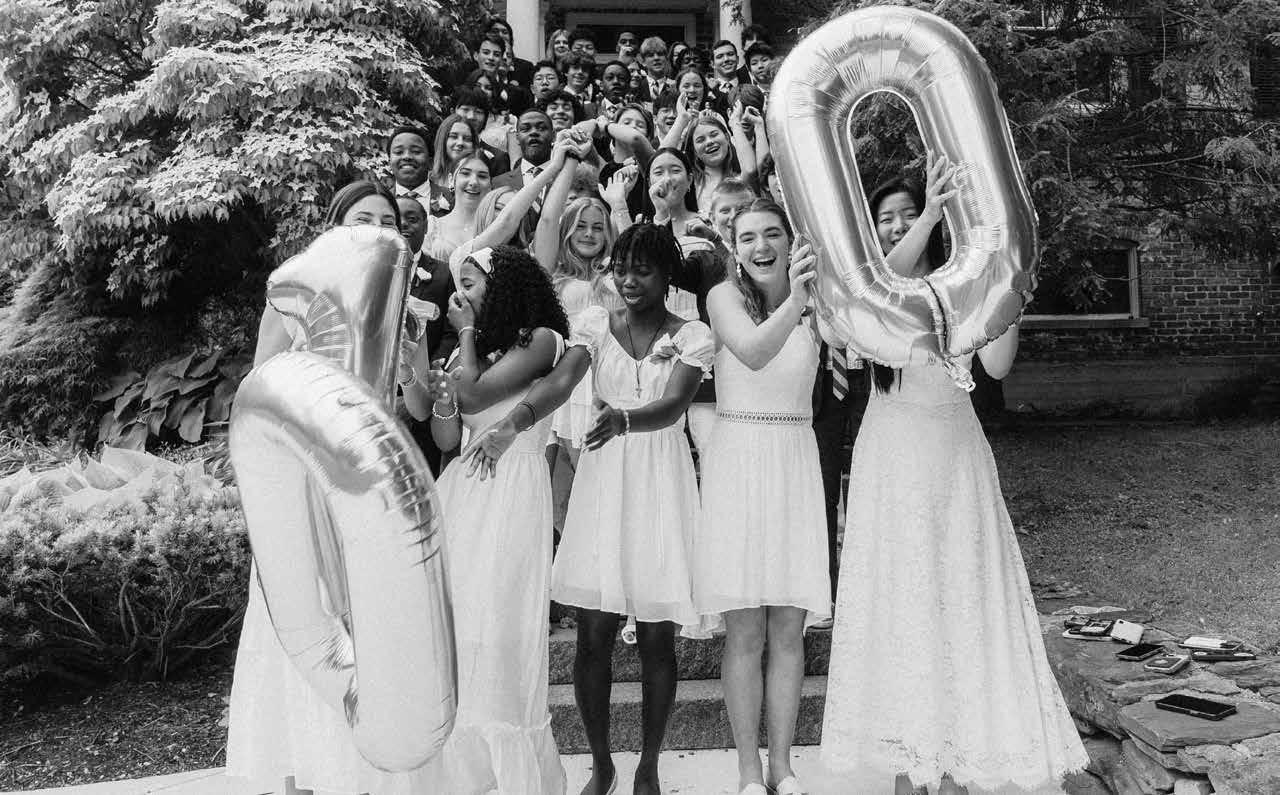
VIEWS
Editors: Emily Benson, Aly Morrissey
Contributors: Emily Benson, Kyle Halloran, Aly Morrissey, Colleen O’Reilly, Tom Stewart, Jody Reilly Soja, Sarah Smith, Amy Tedder
Photographers: Sam Decock (archival photographs from various sources).
Design: Graphic Details, Inc.
Printing: Qualprint
